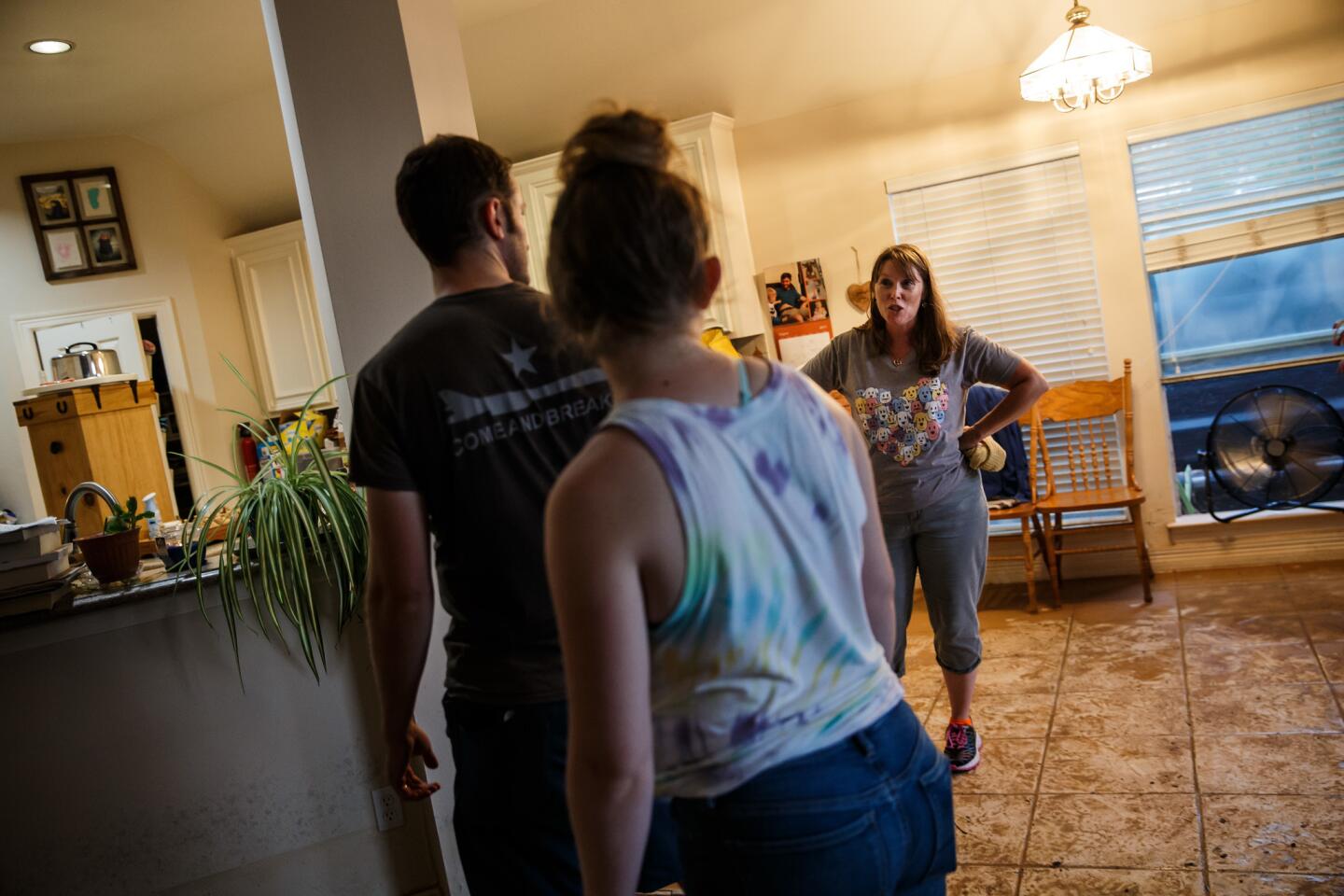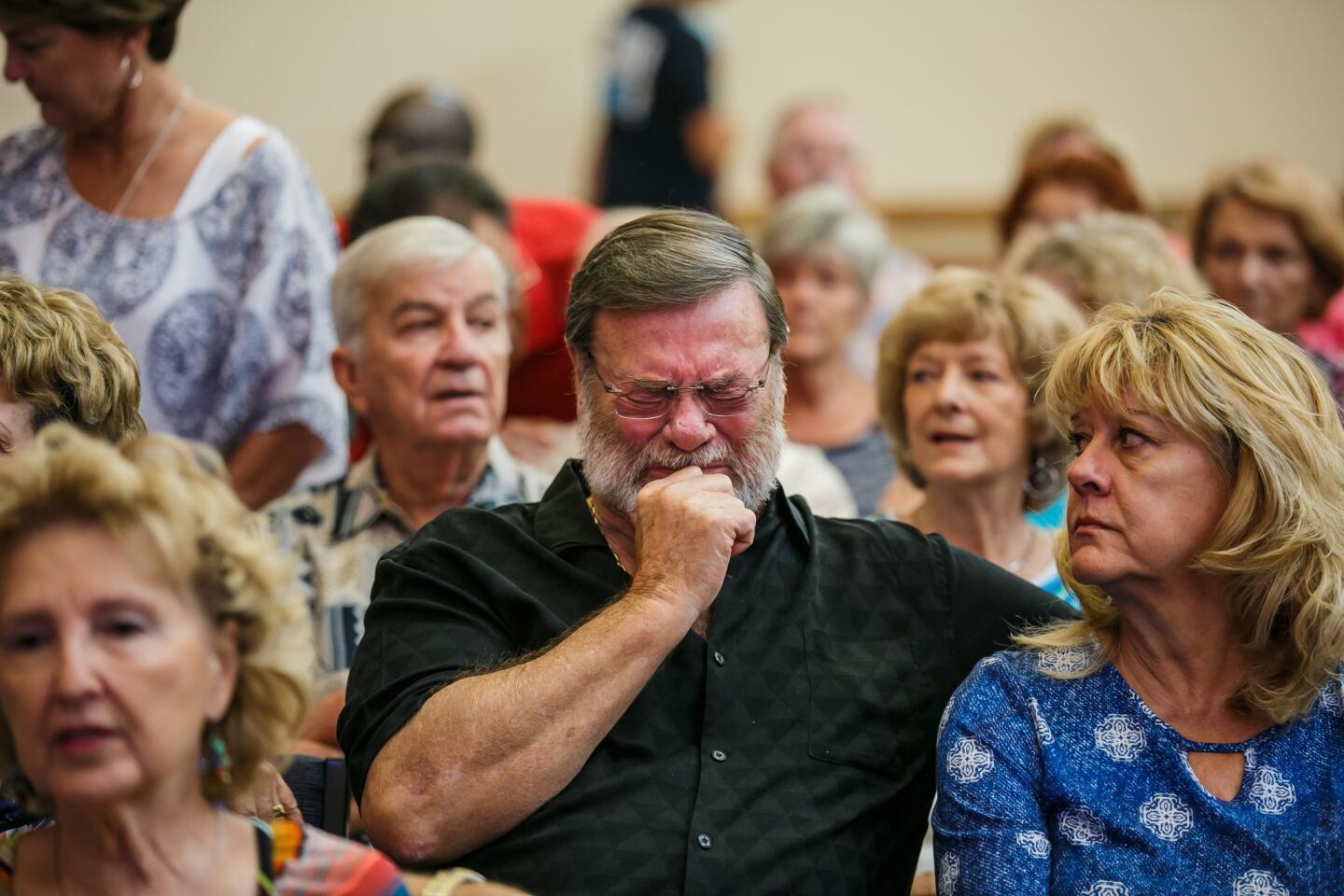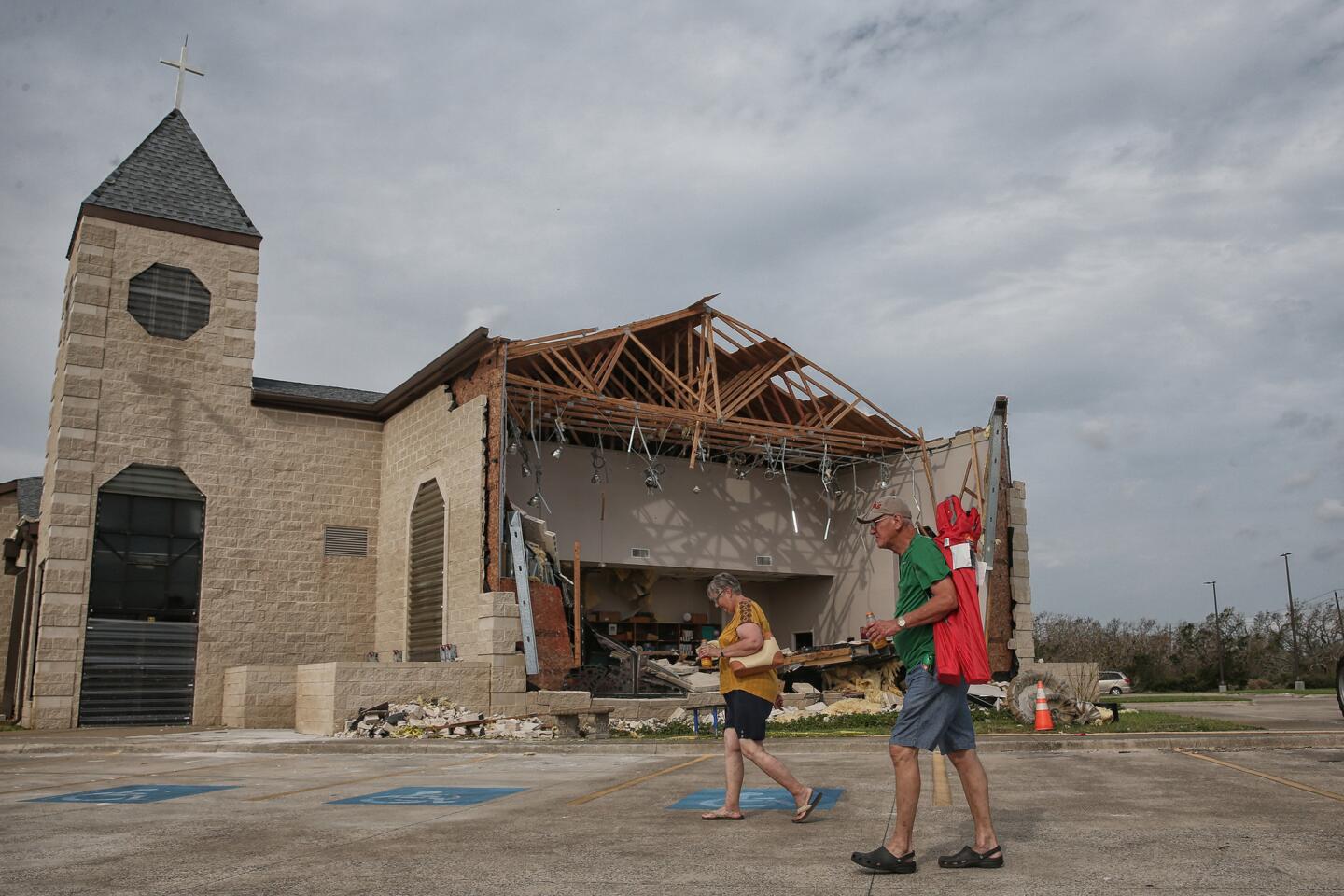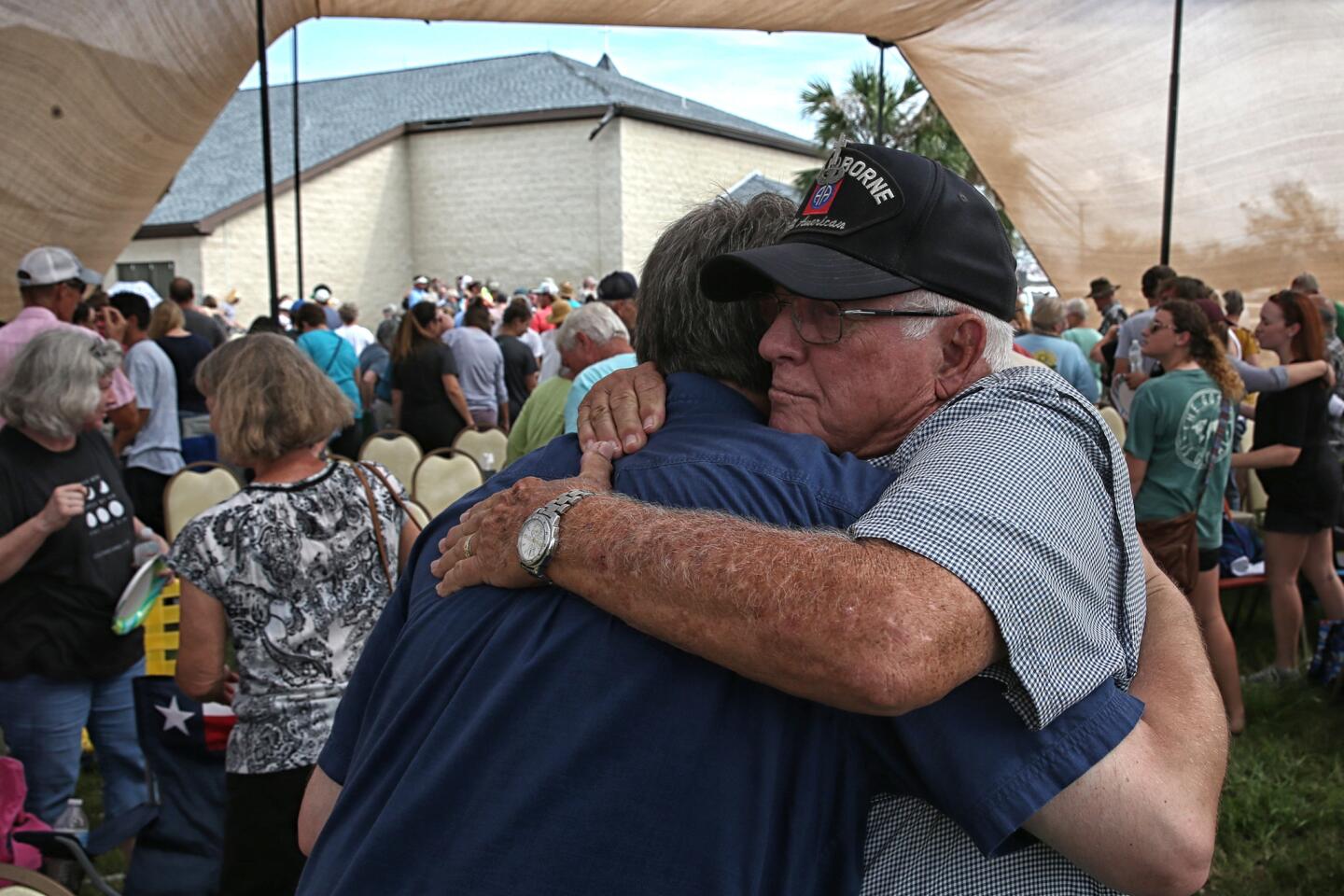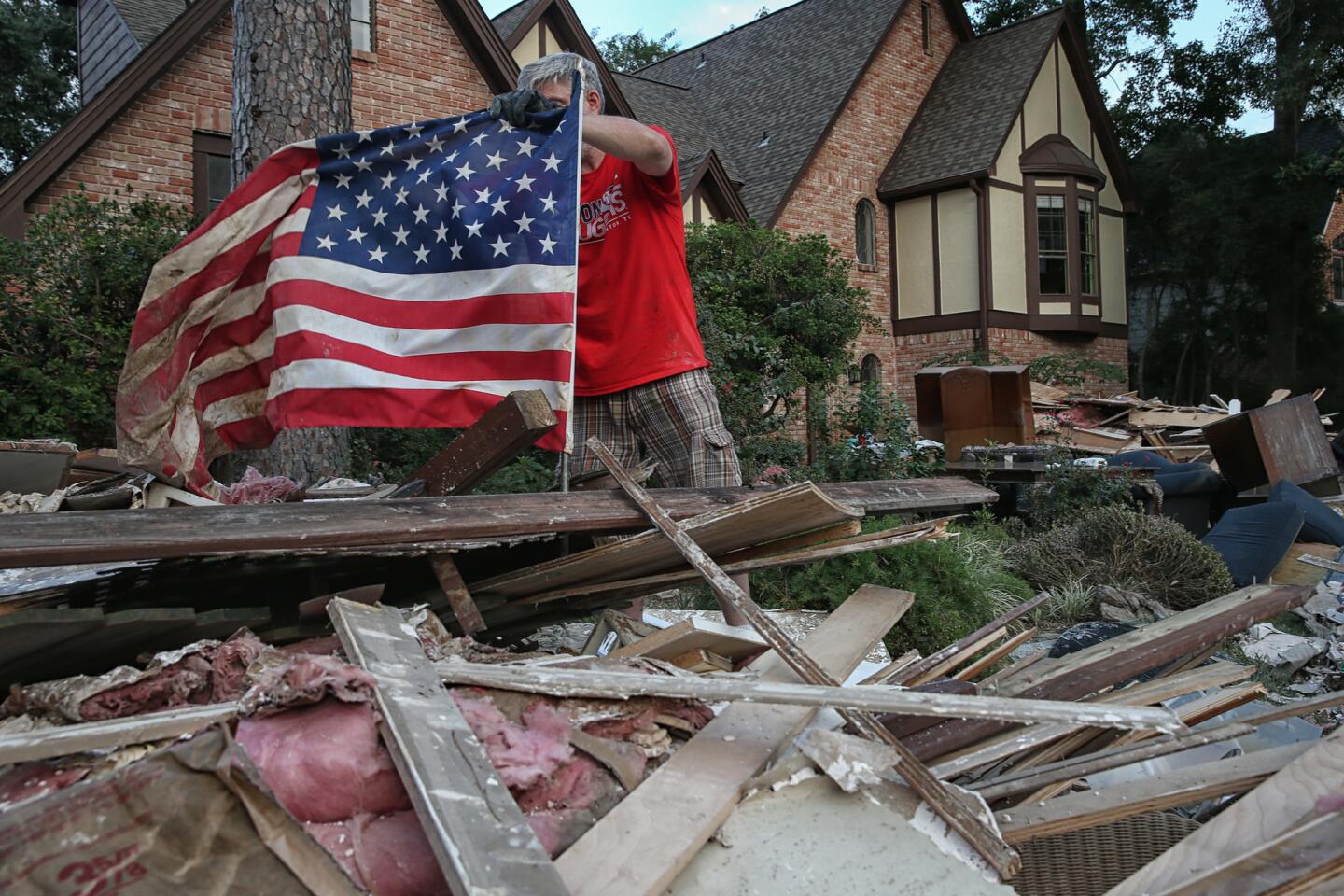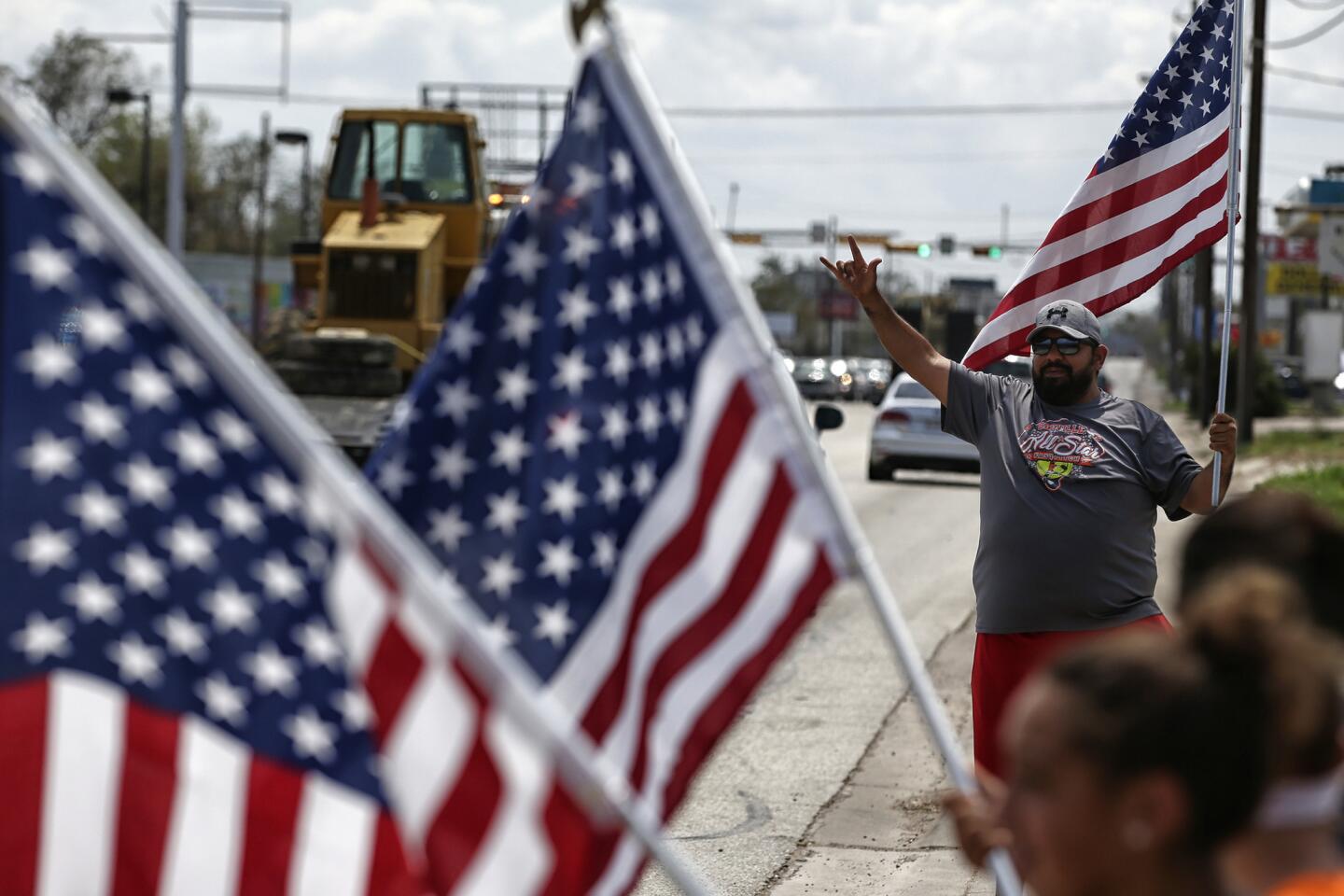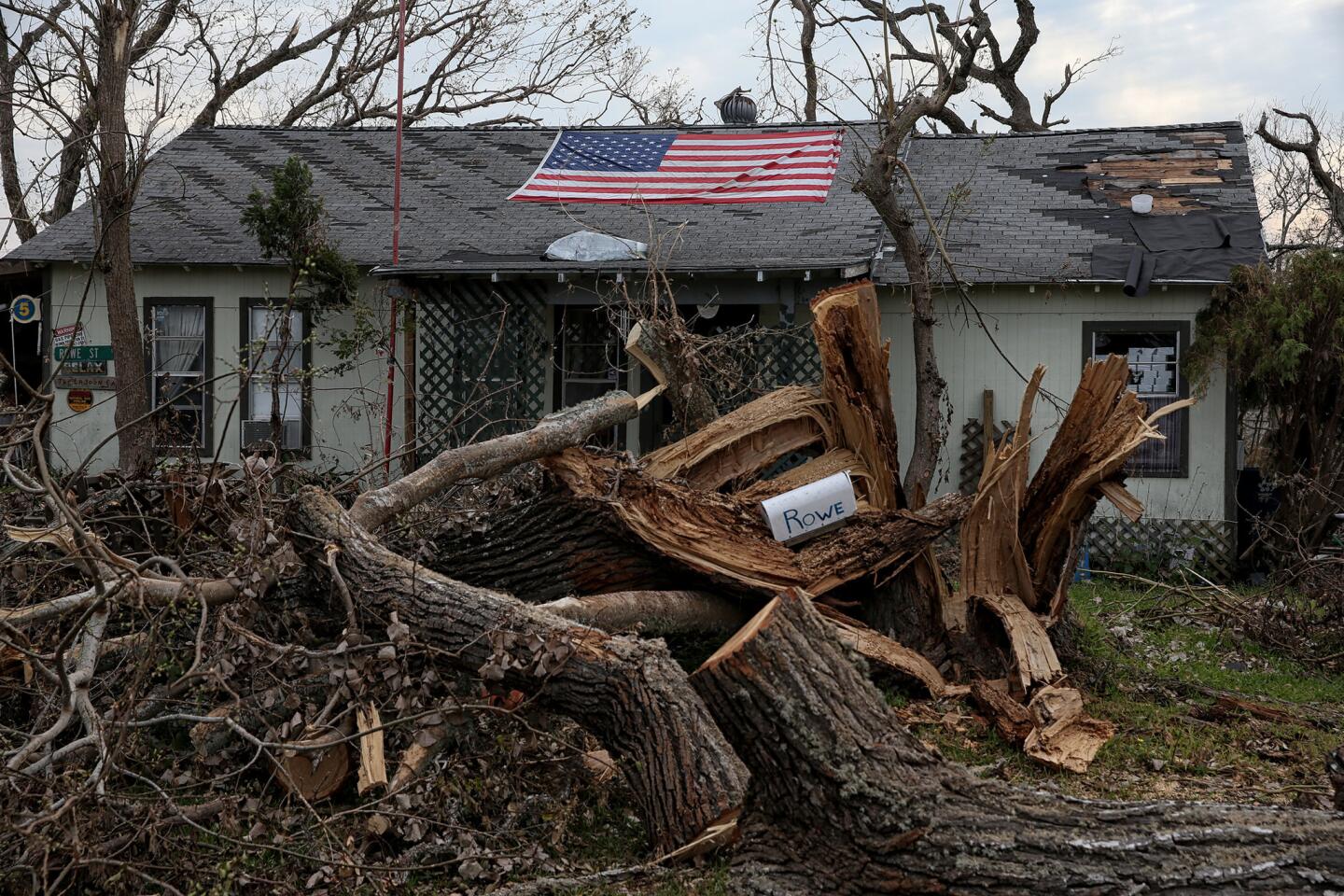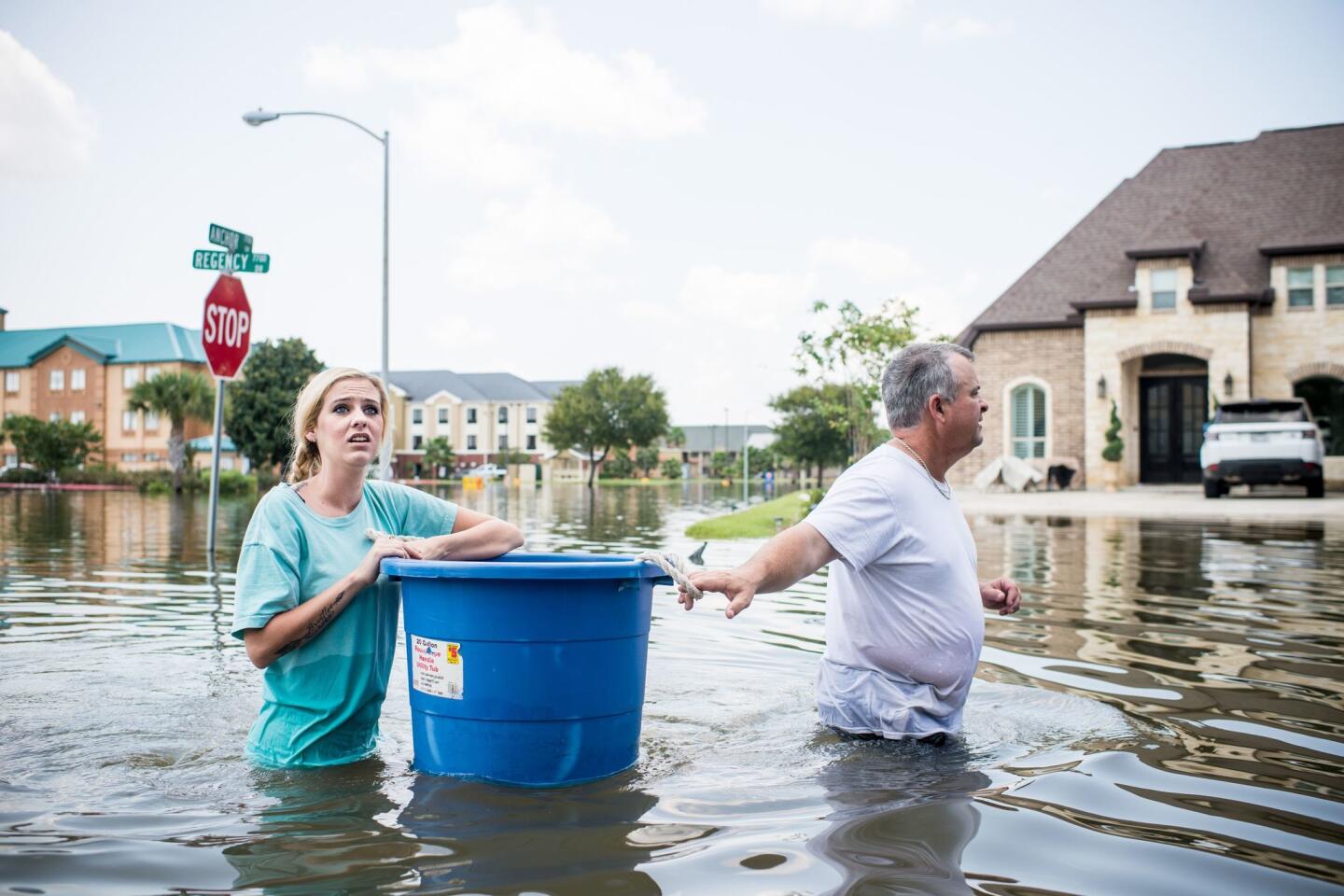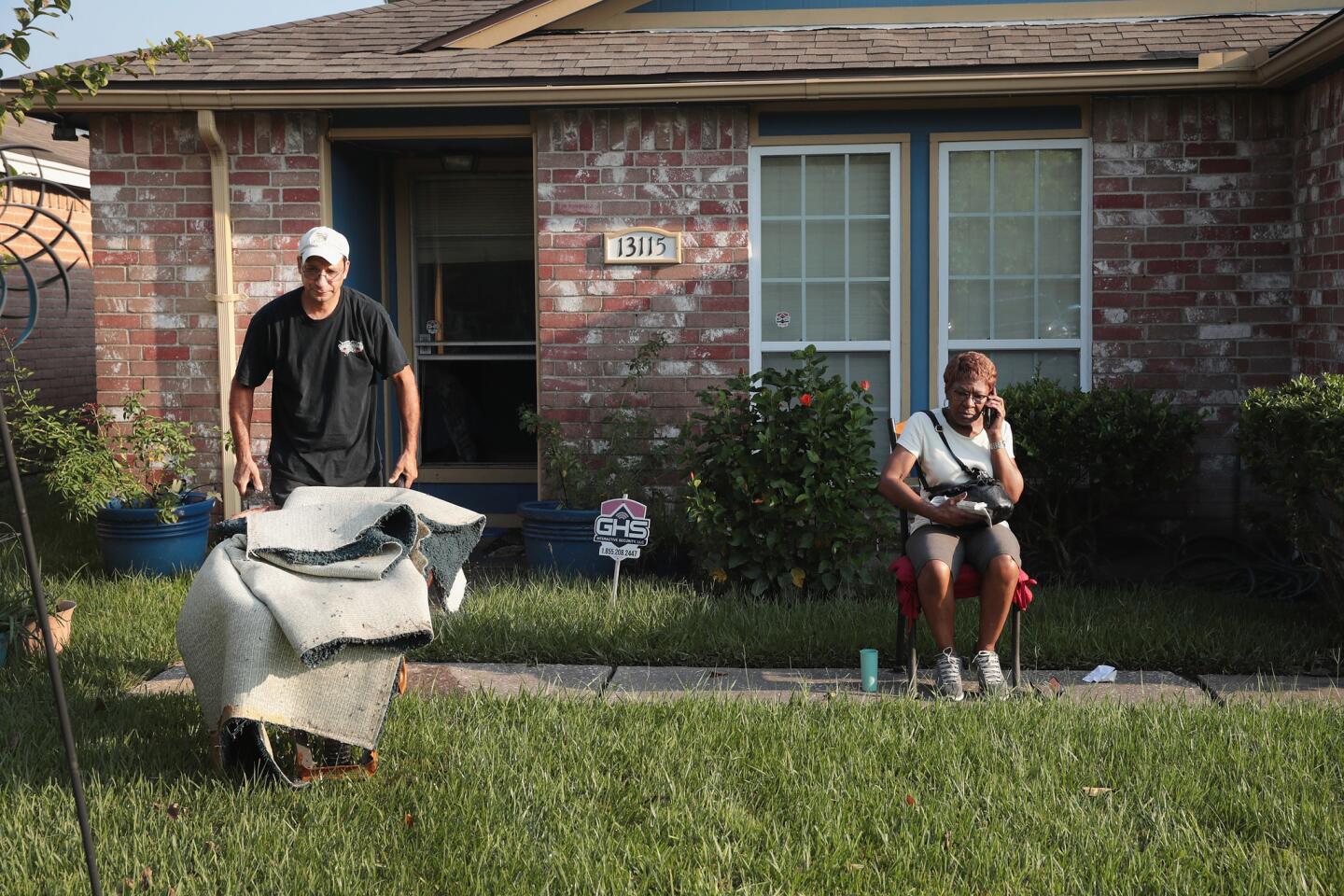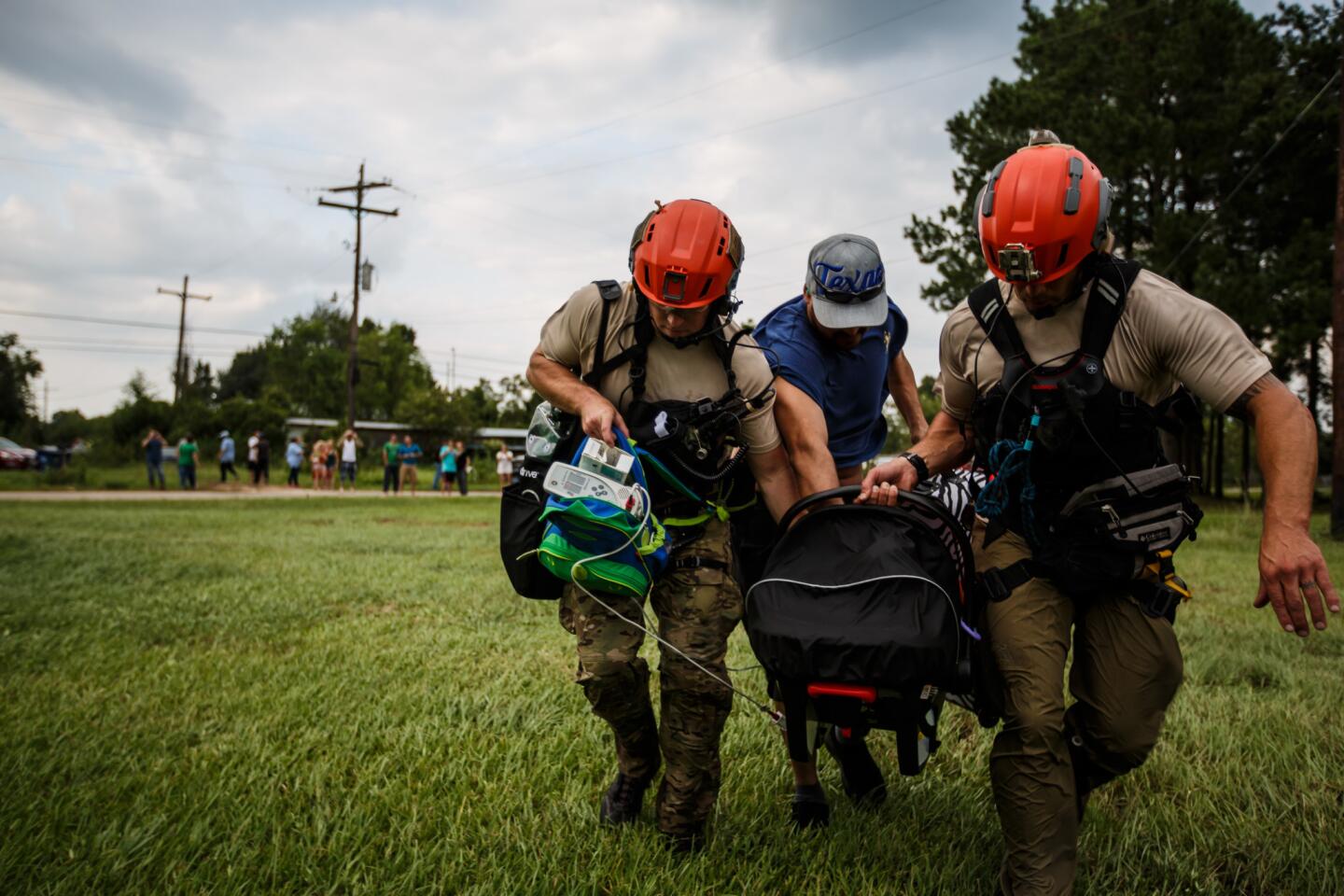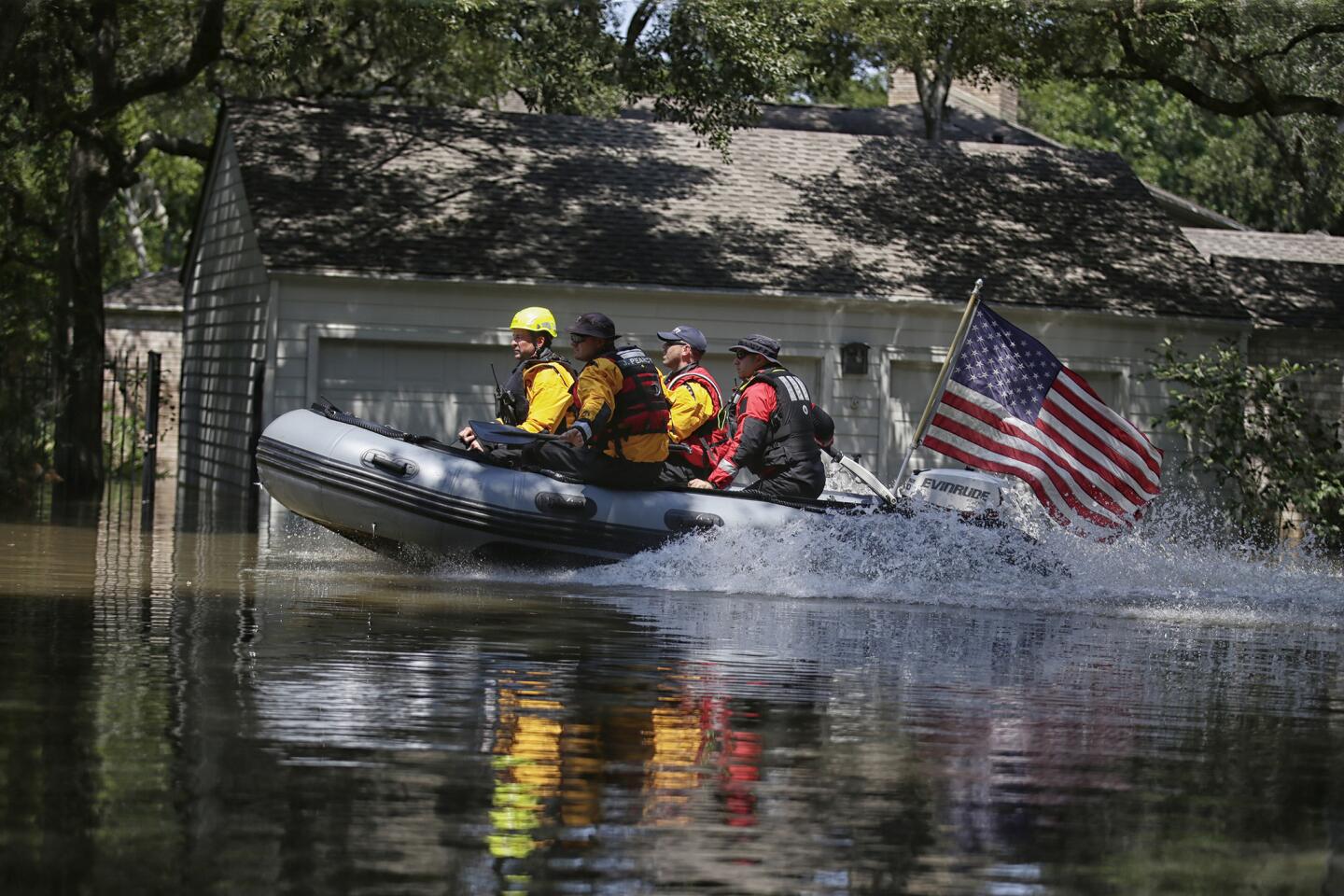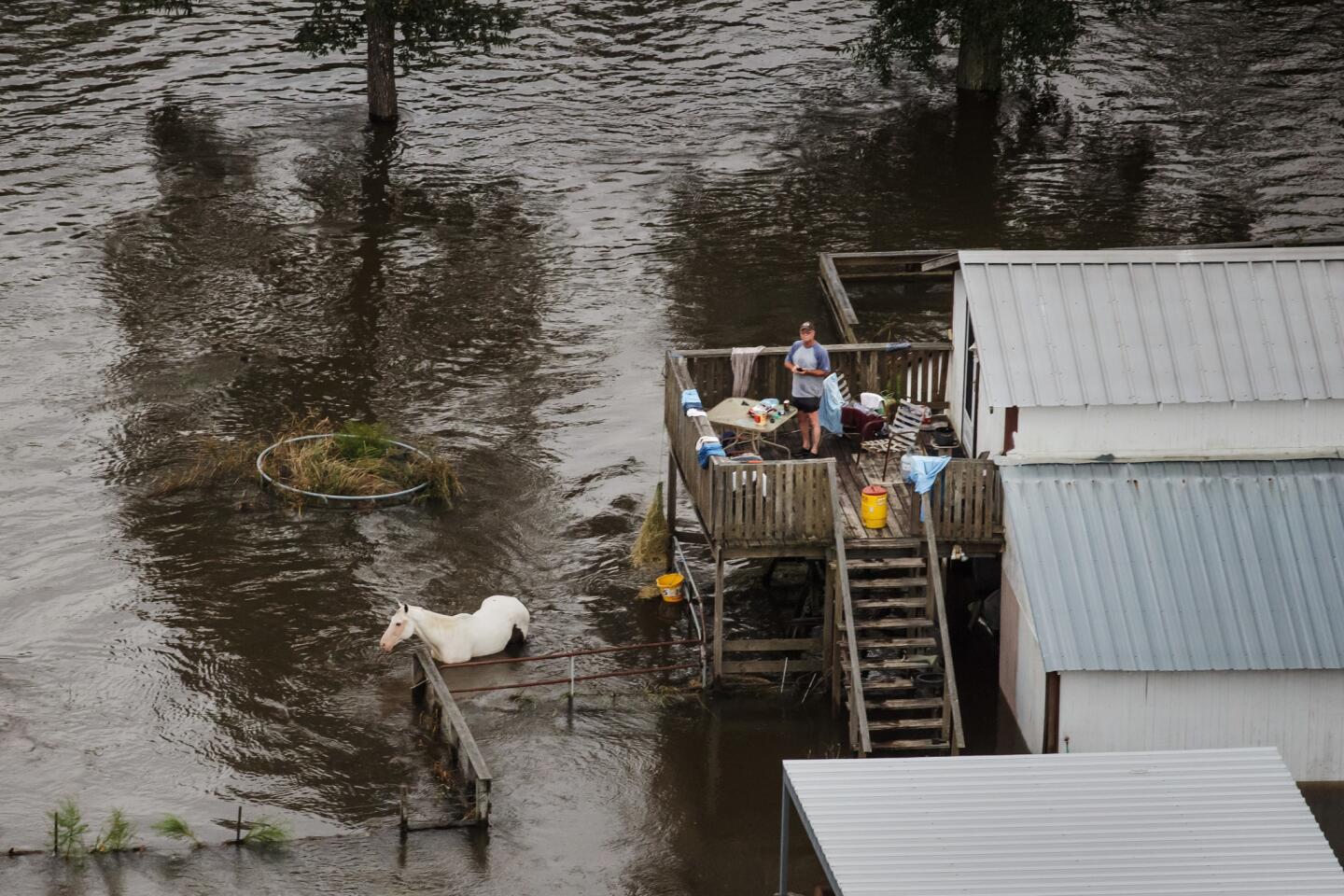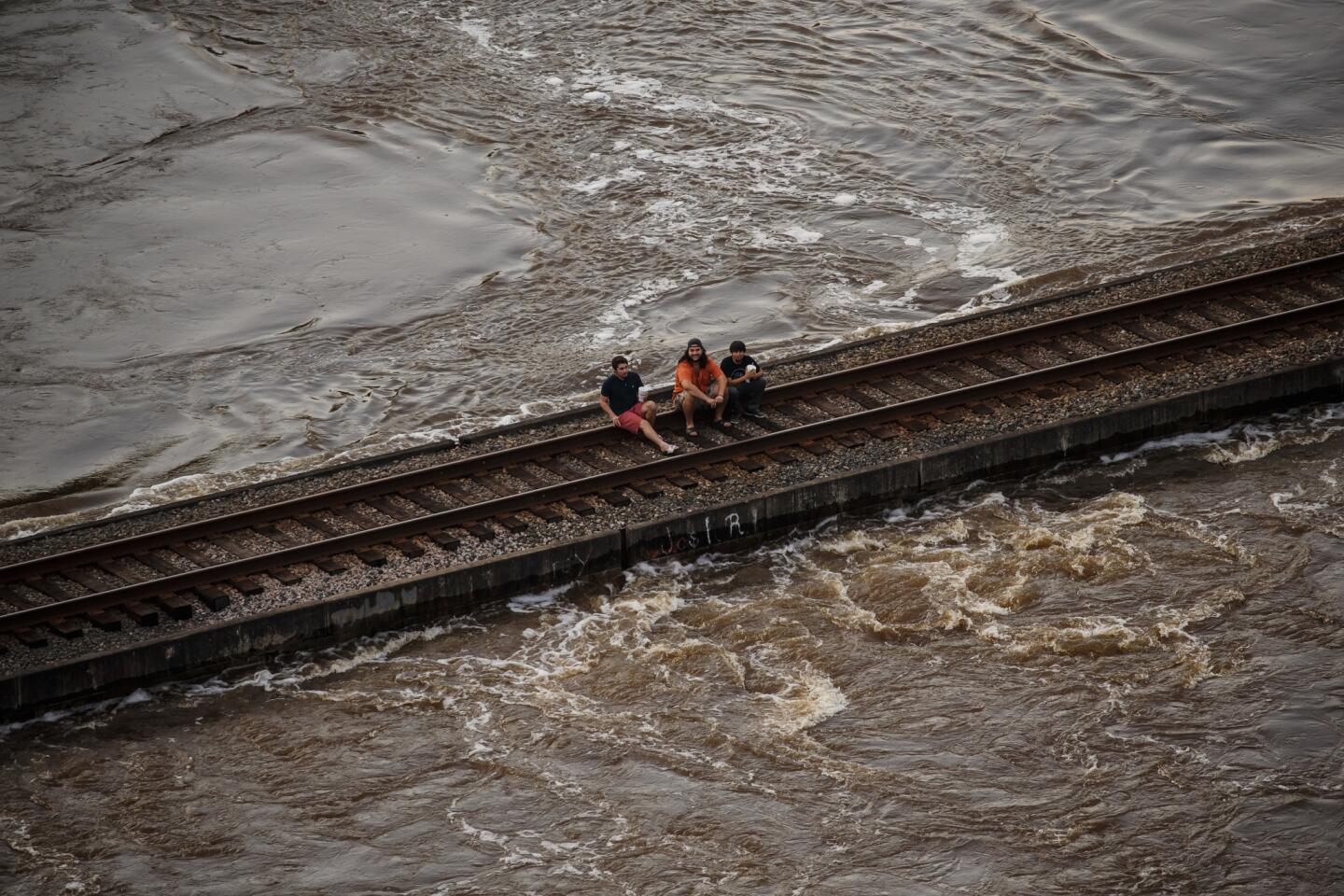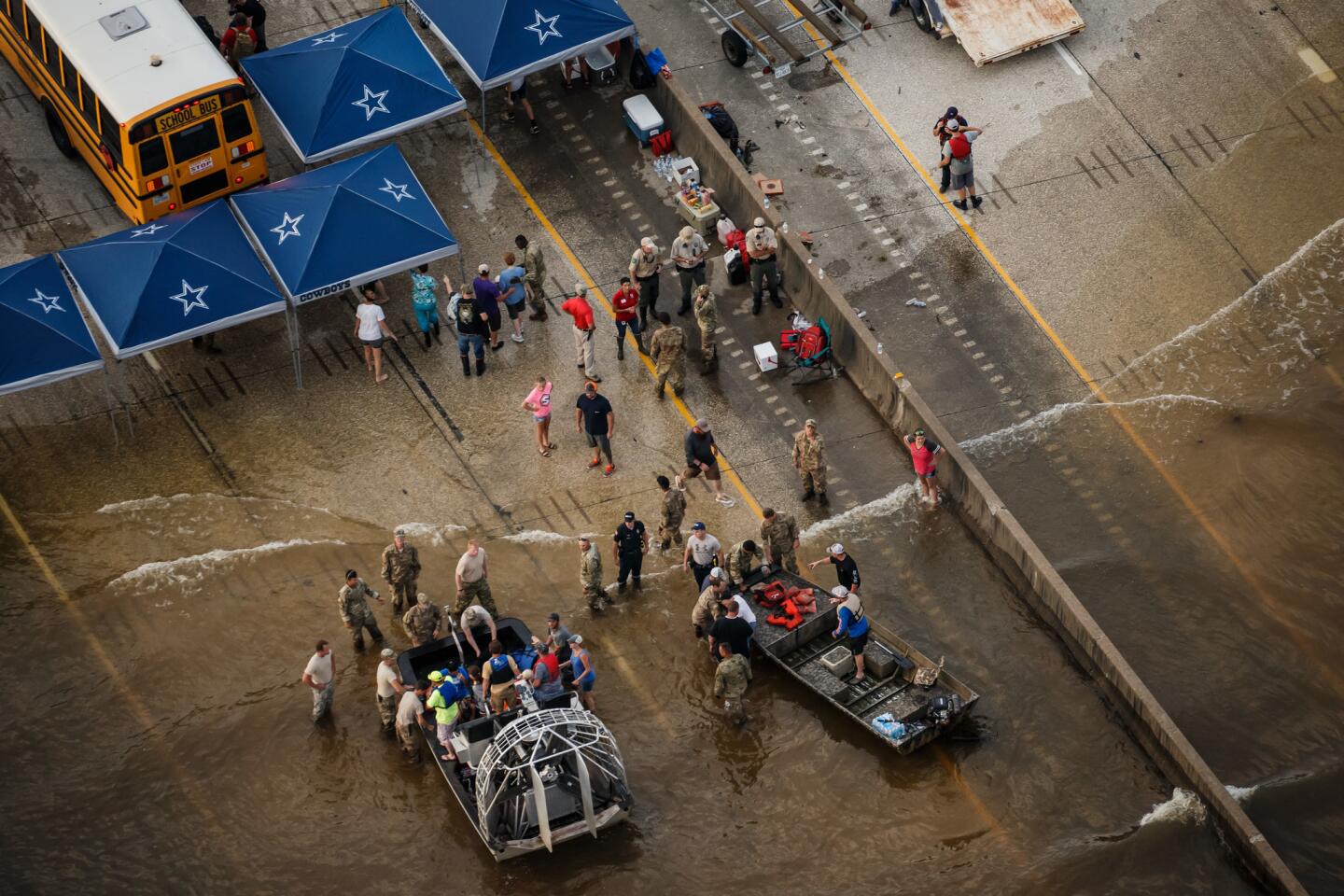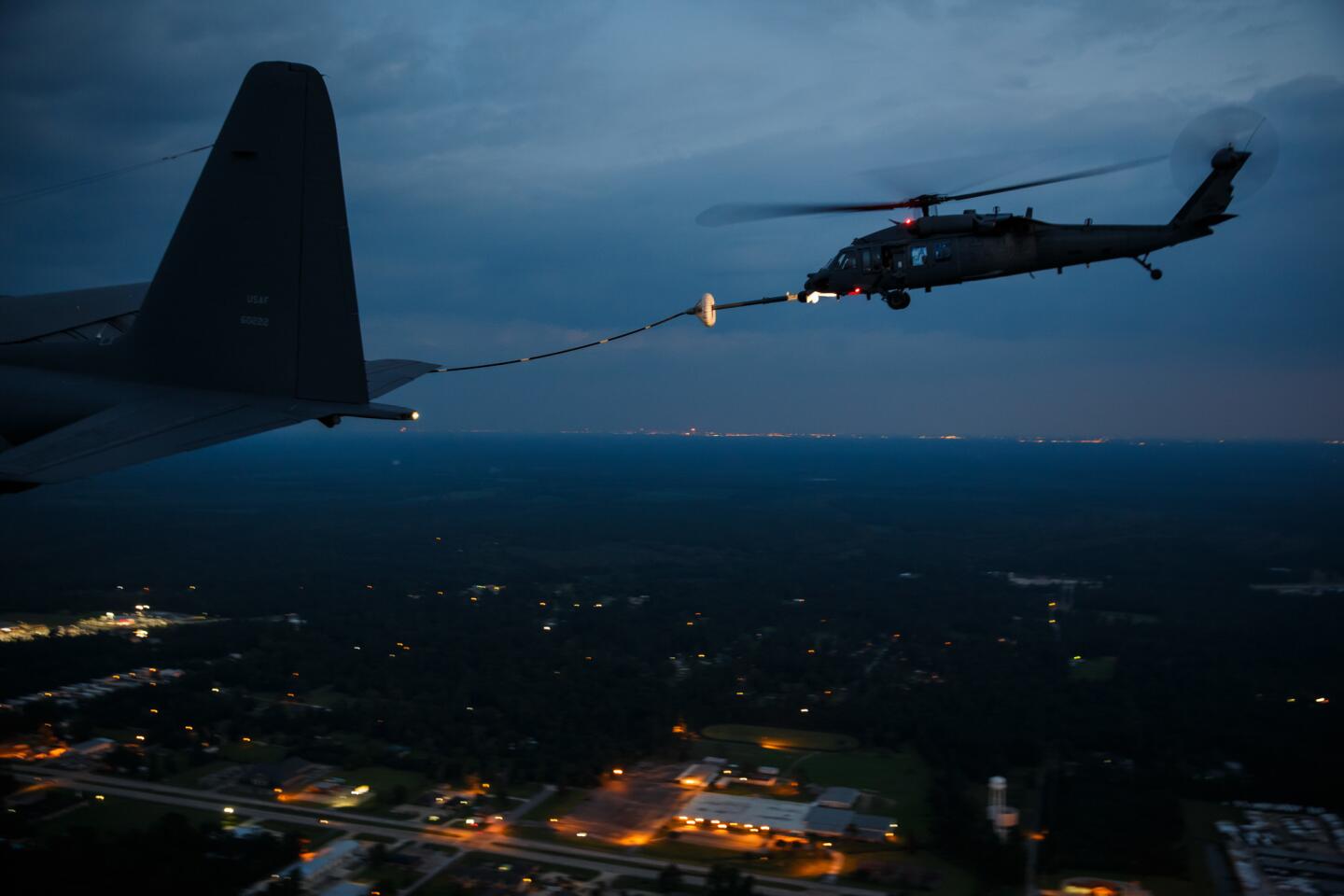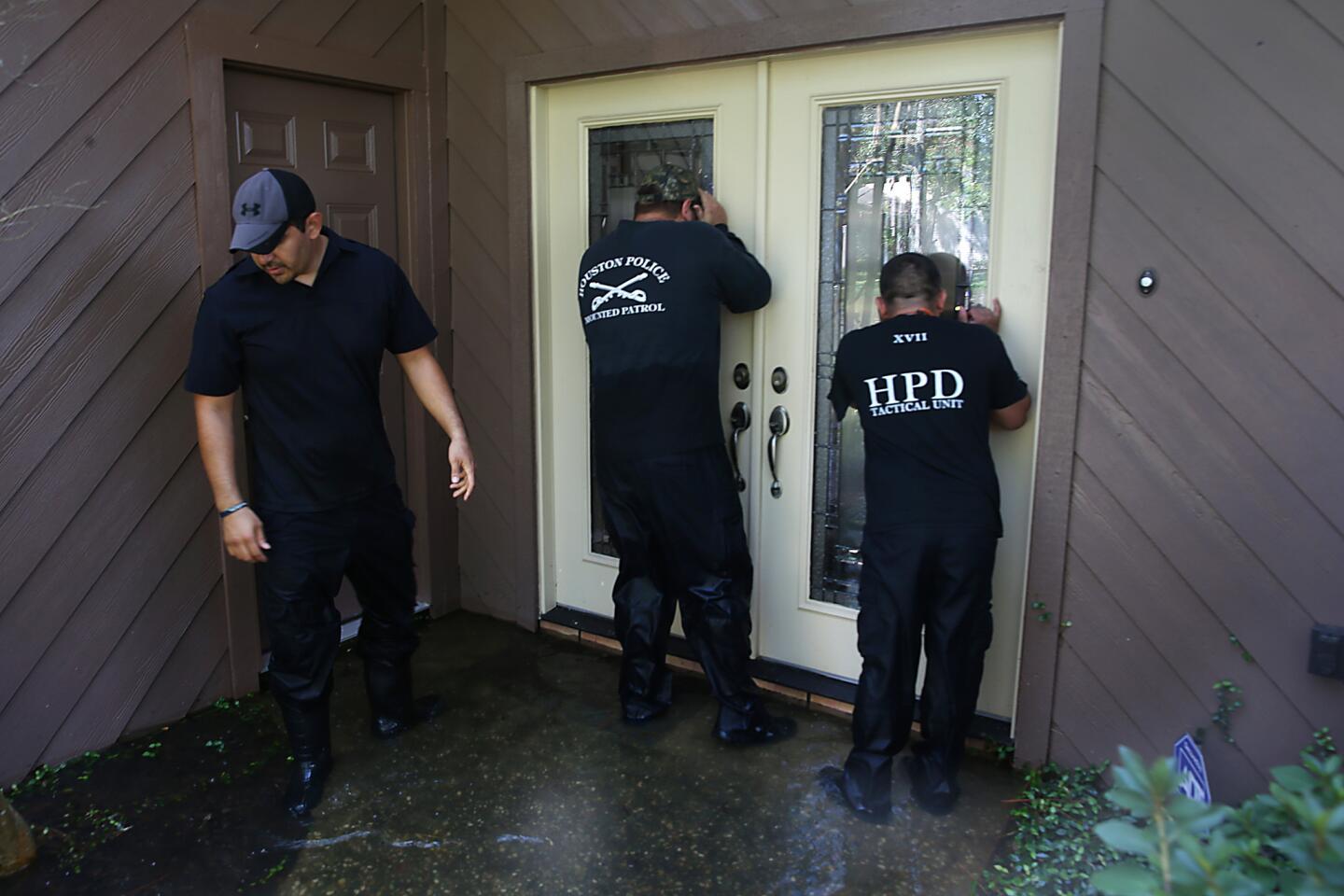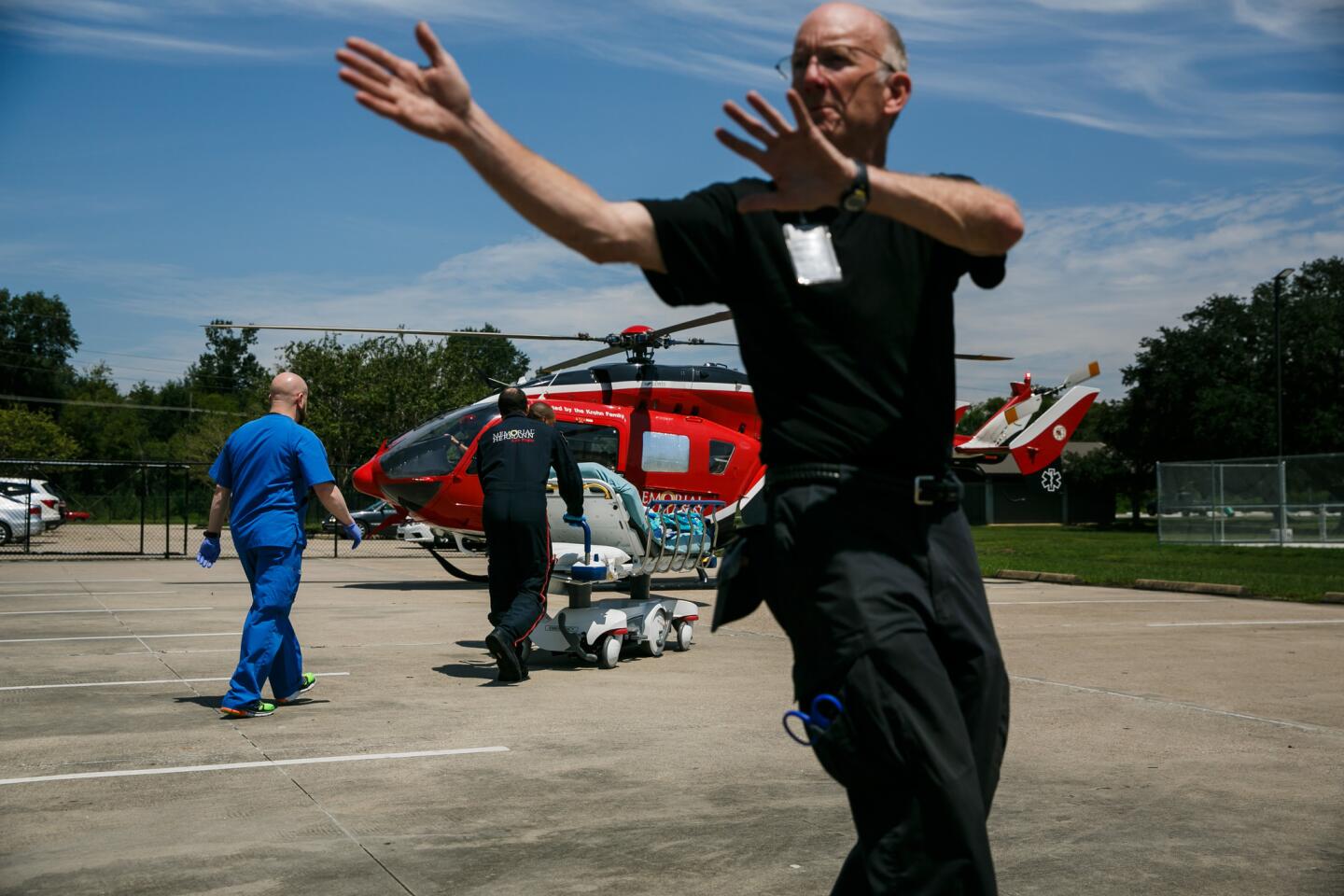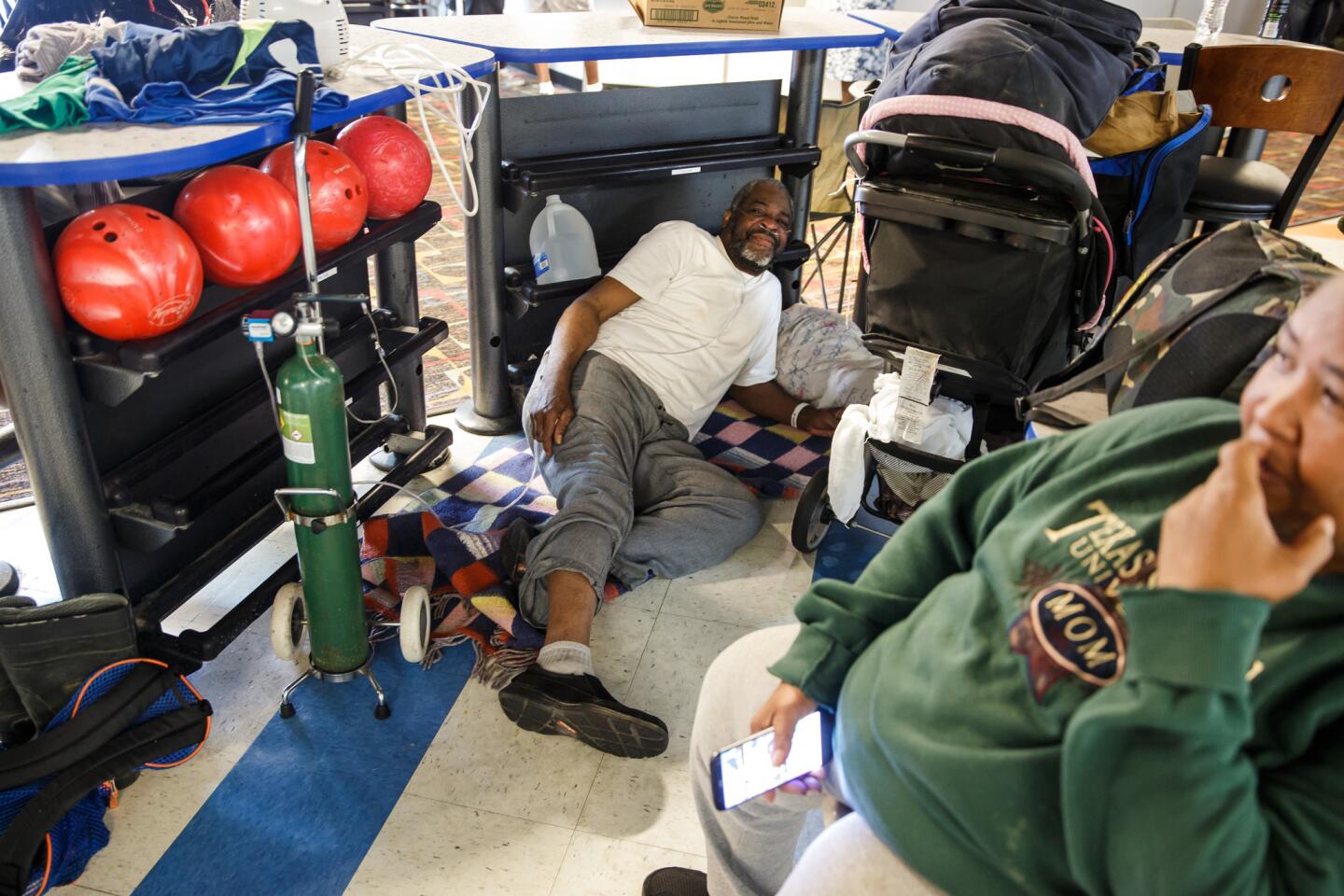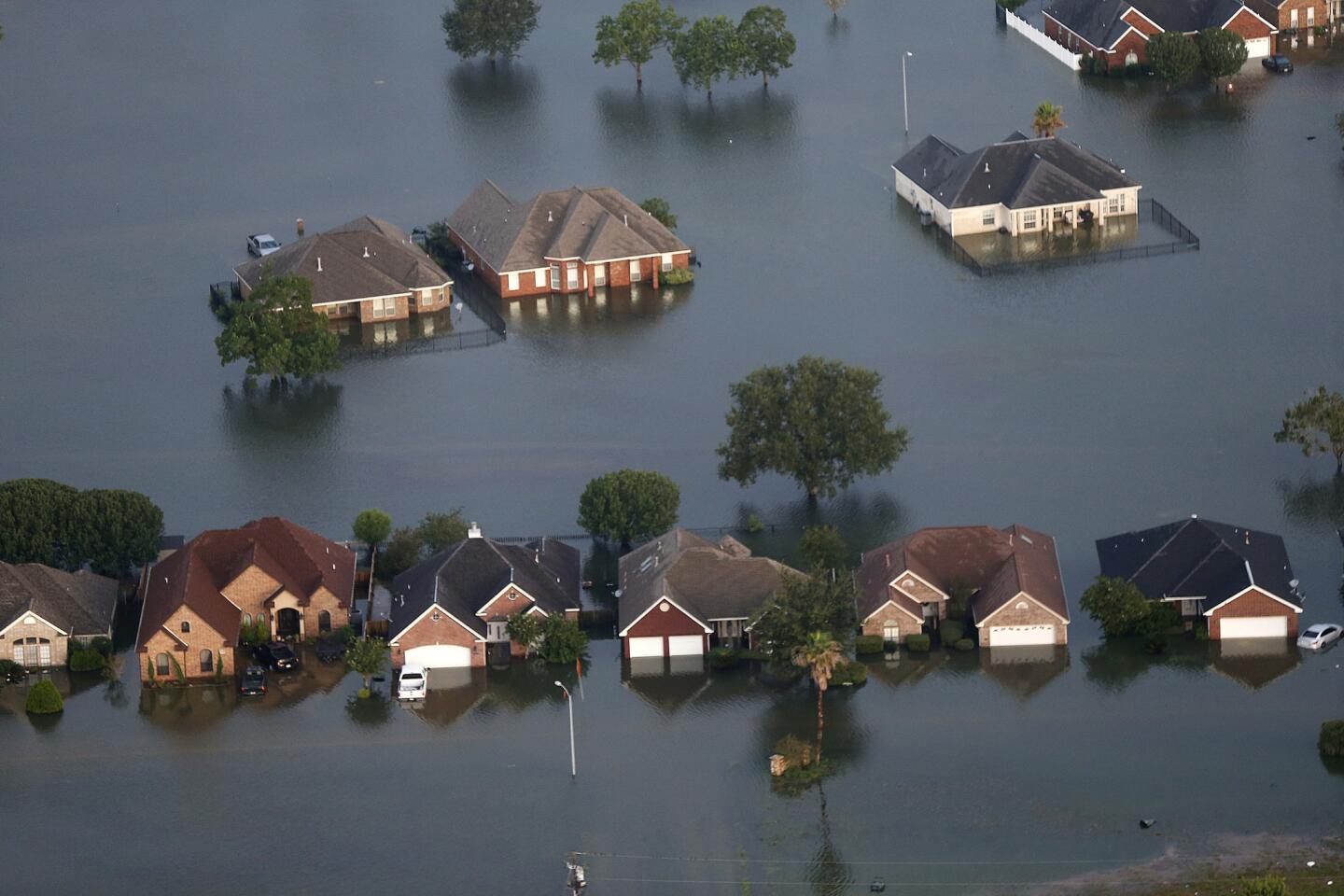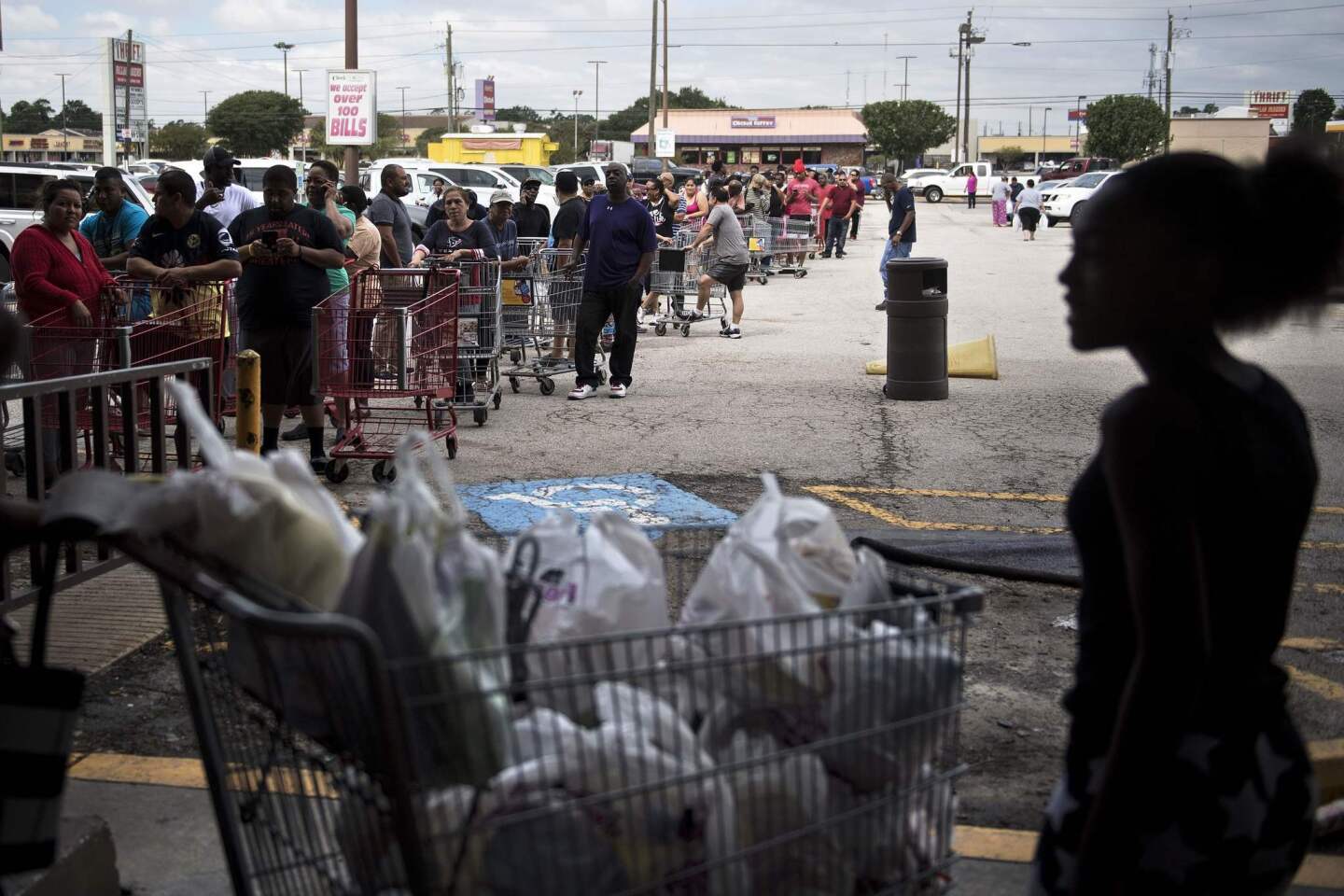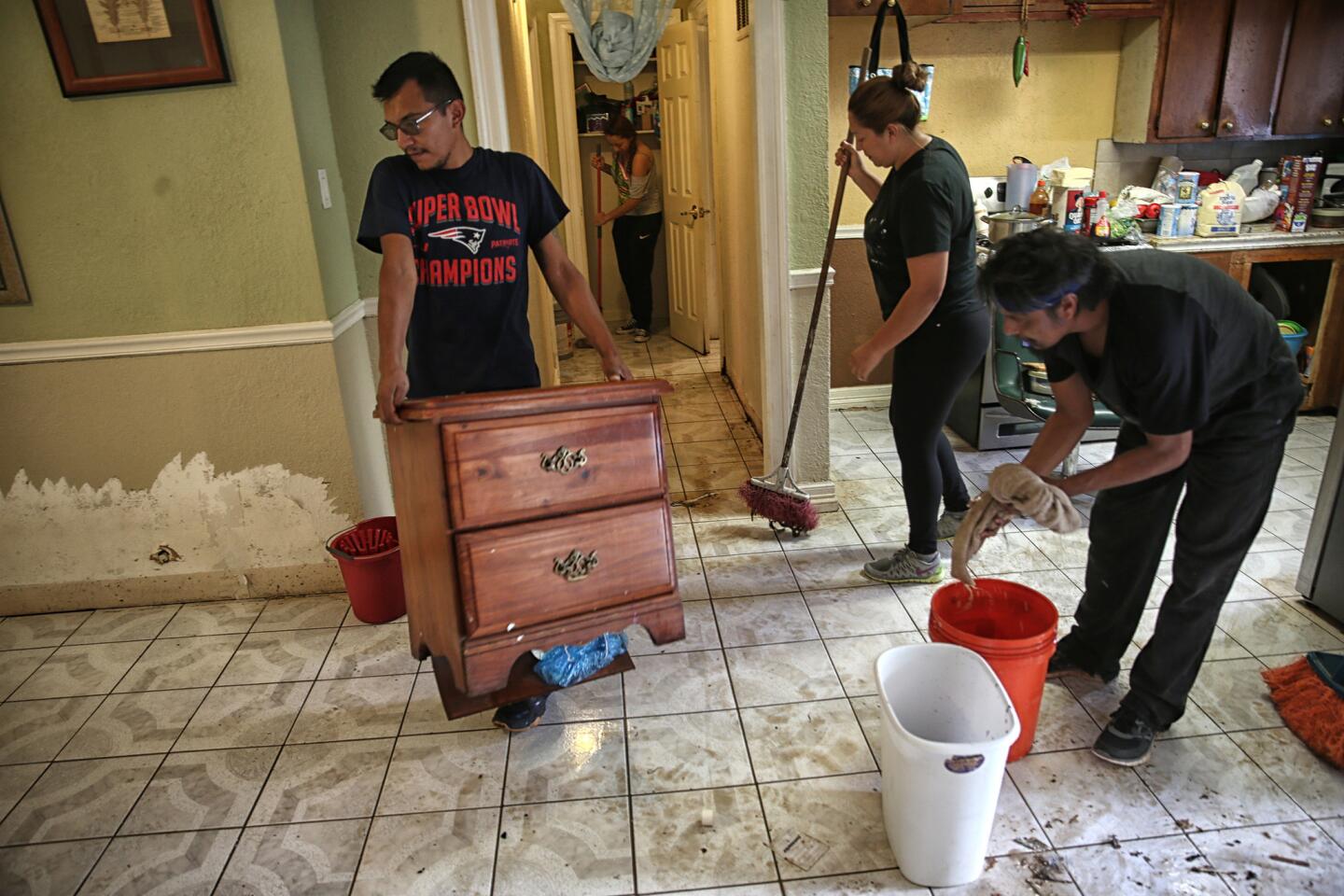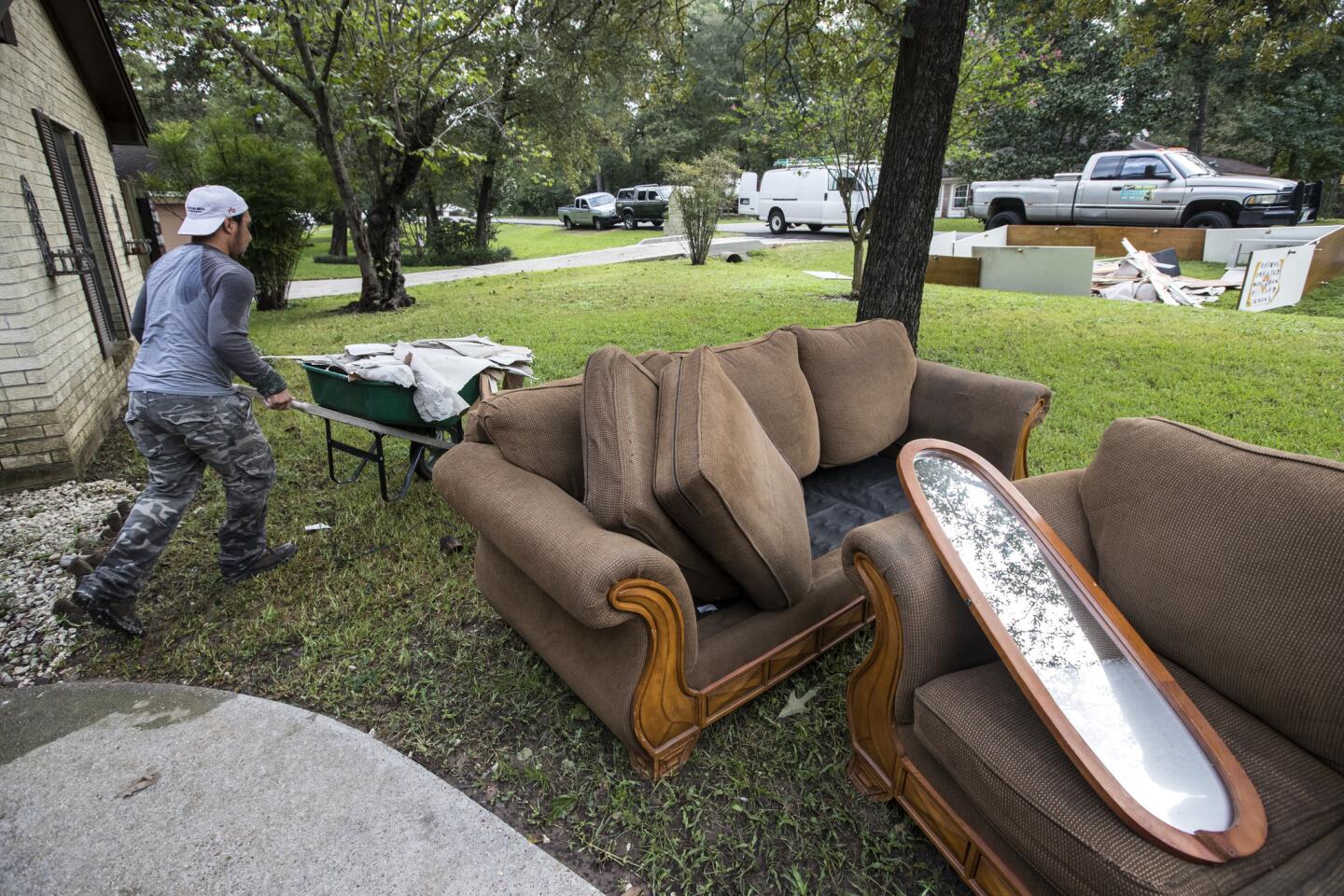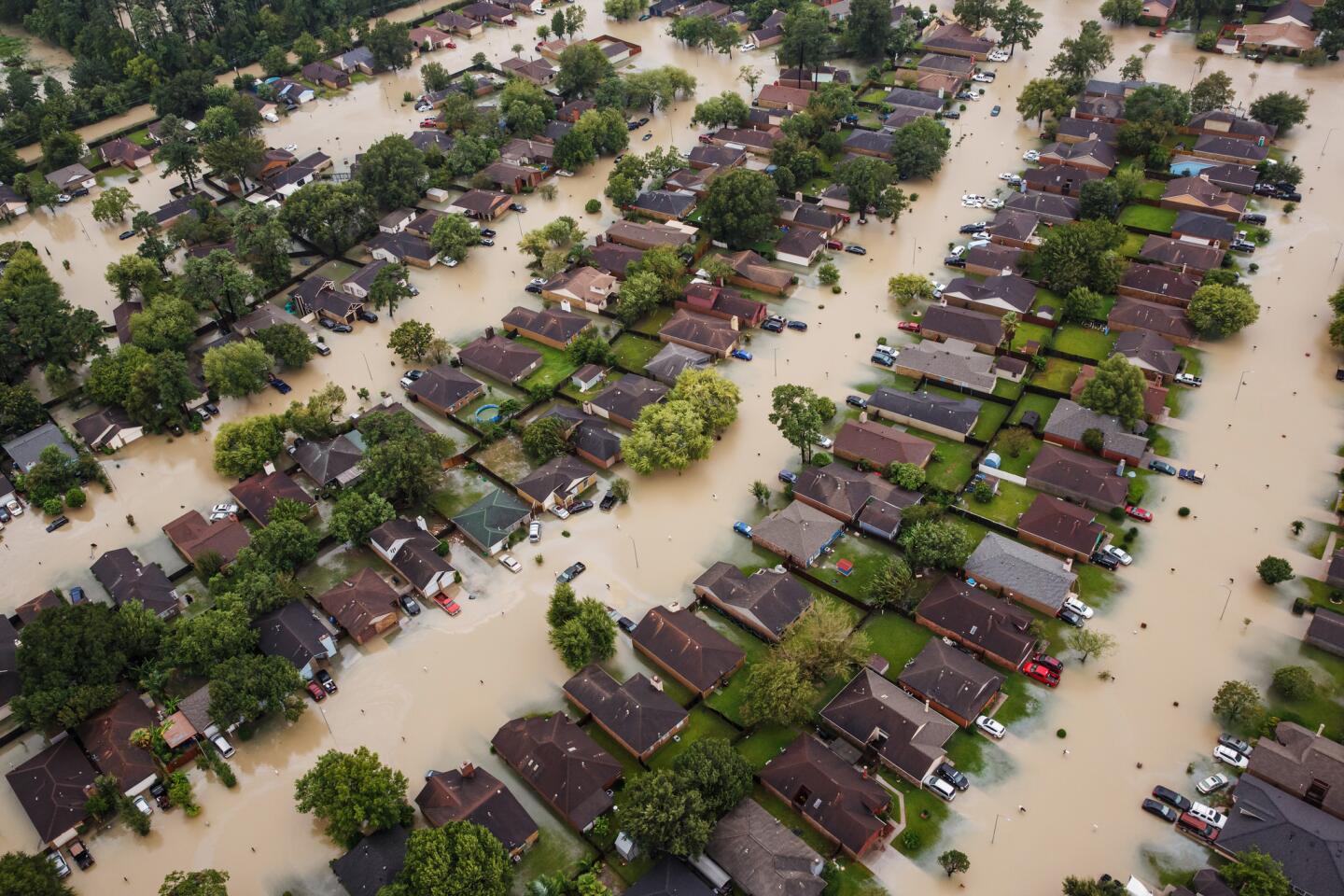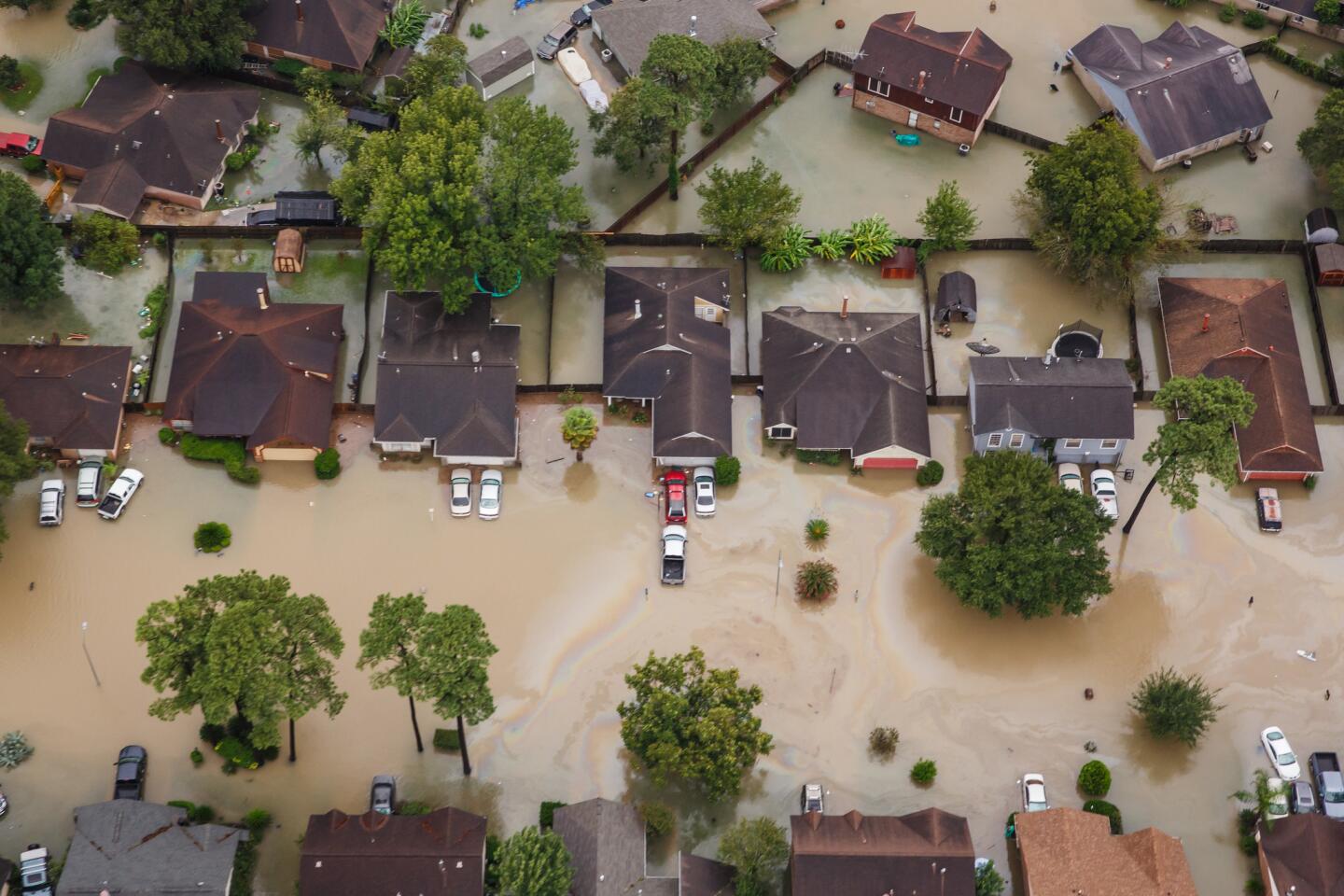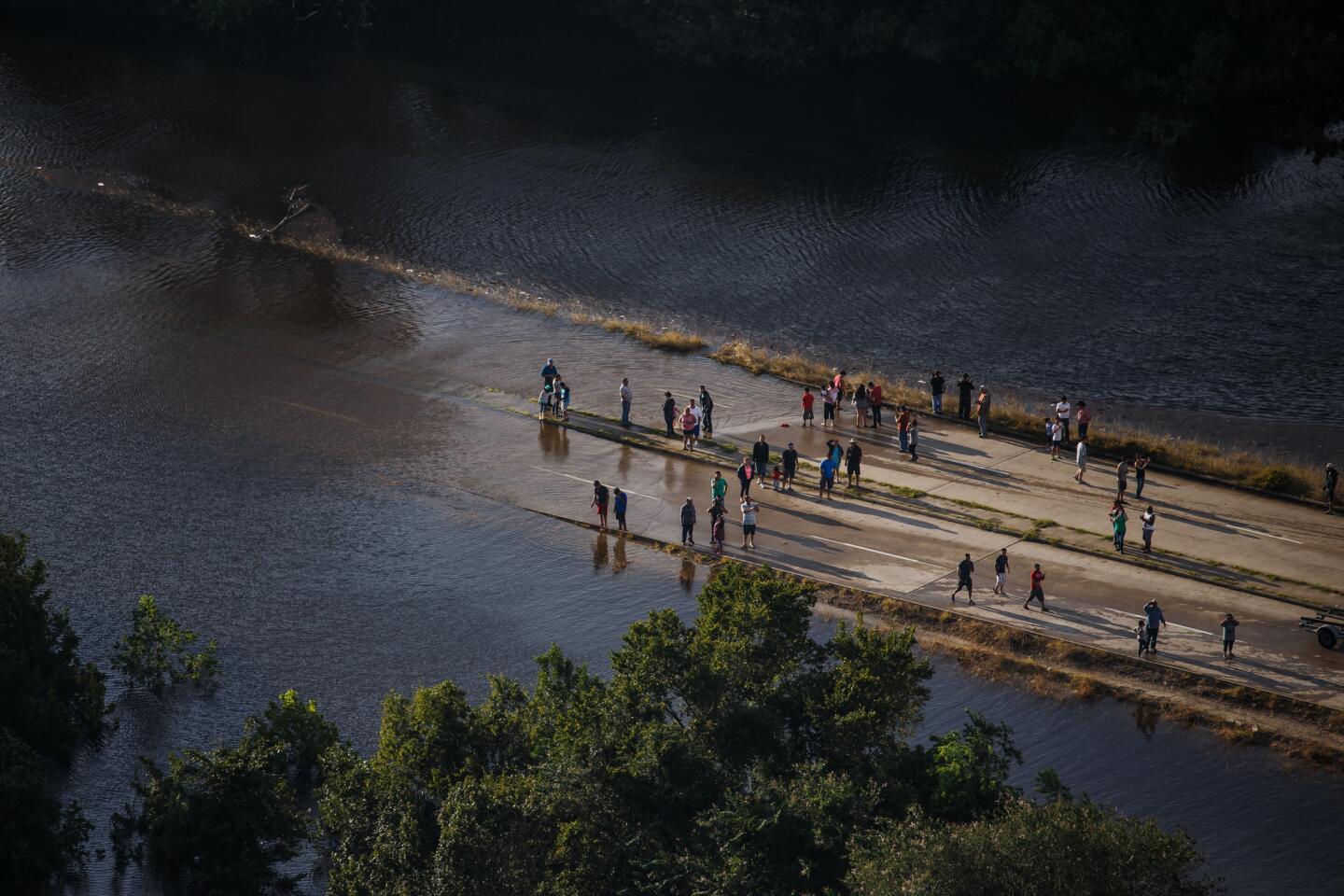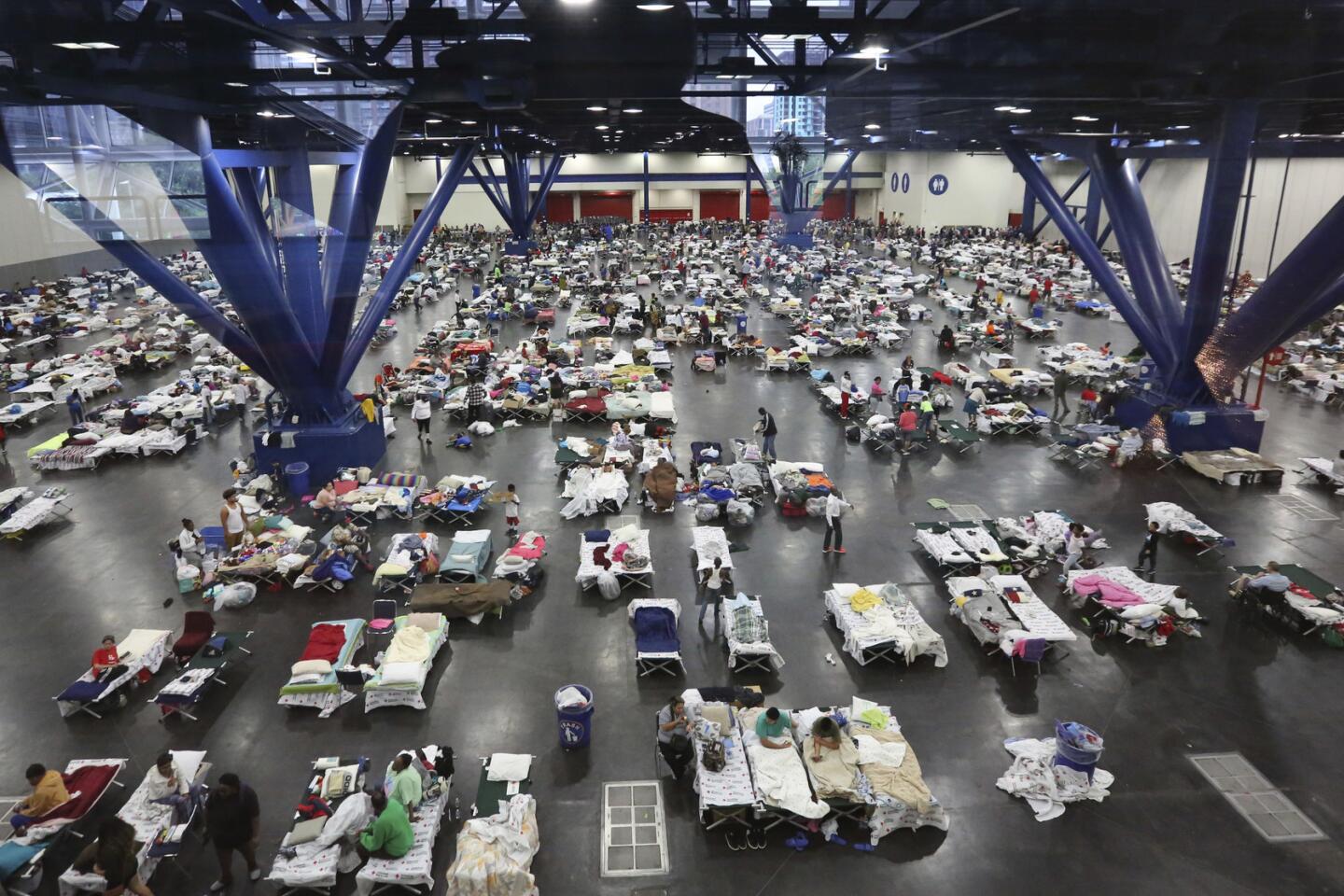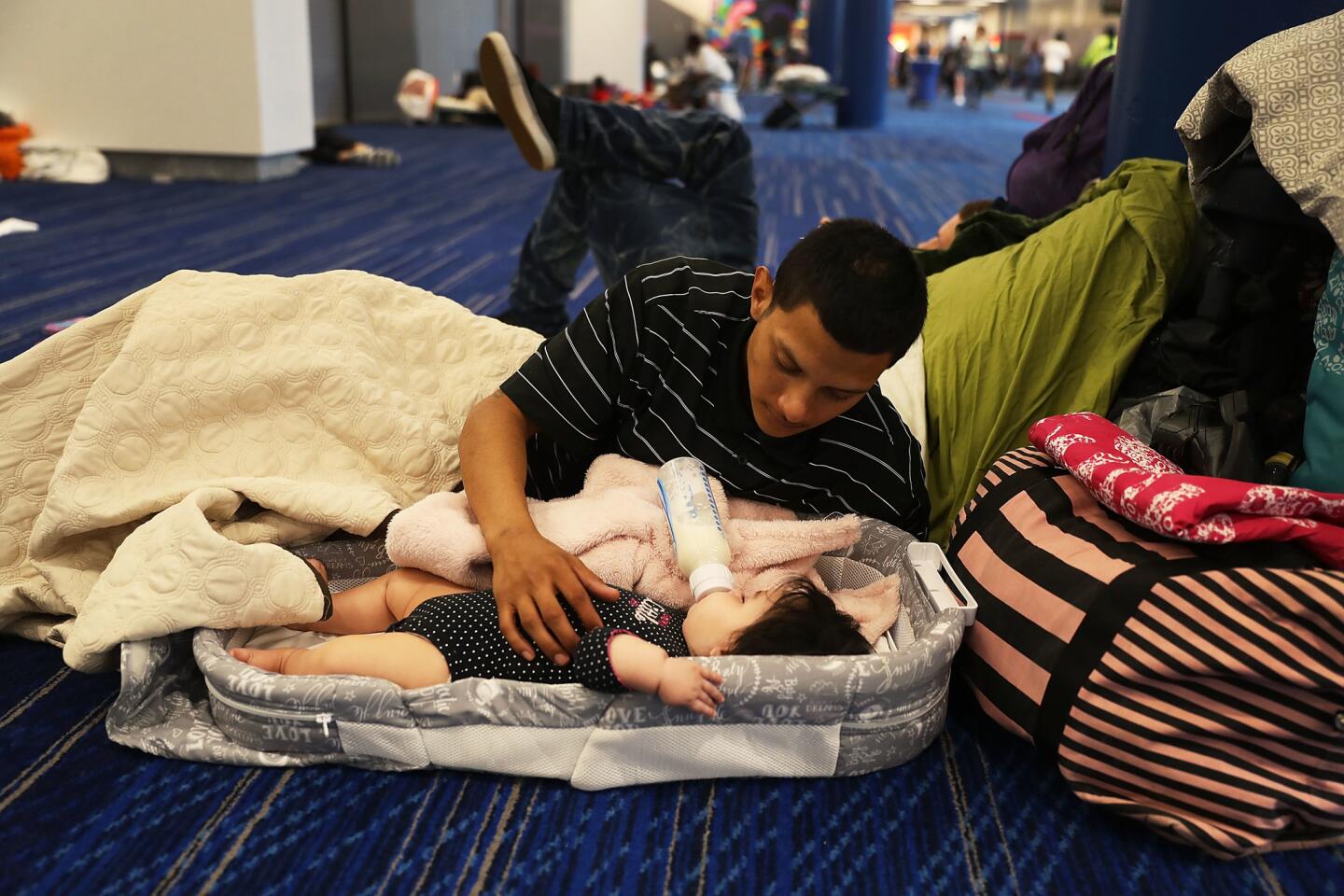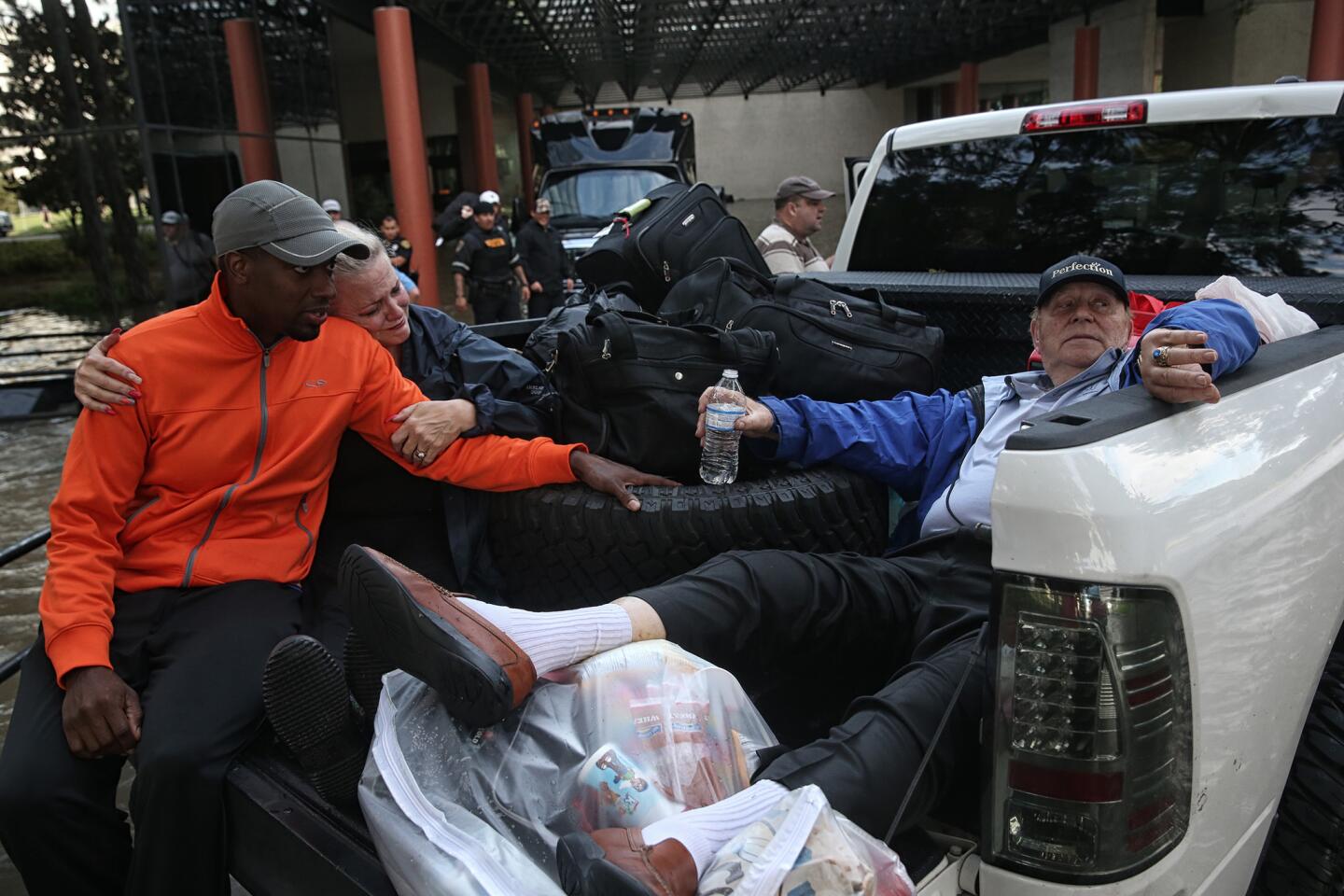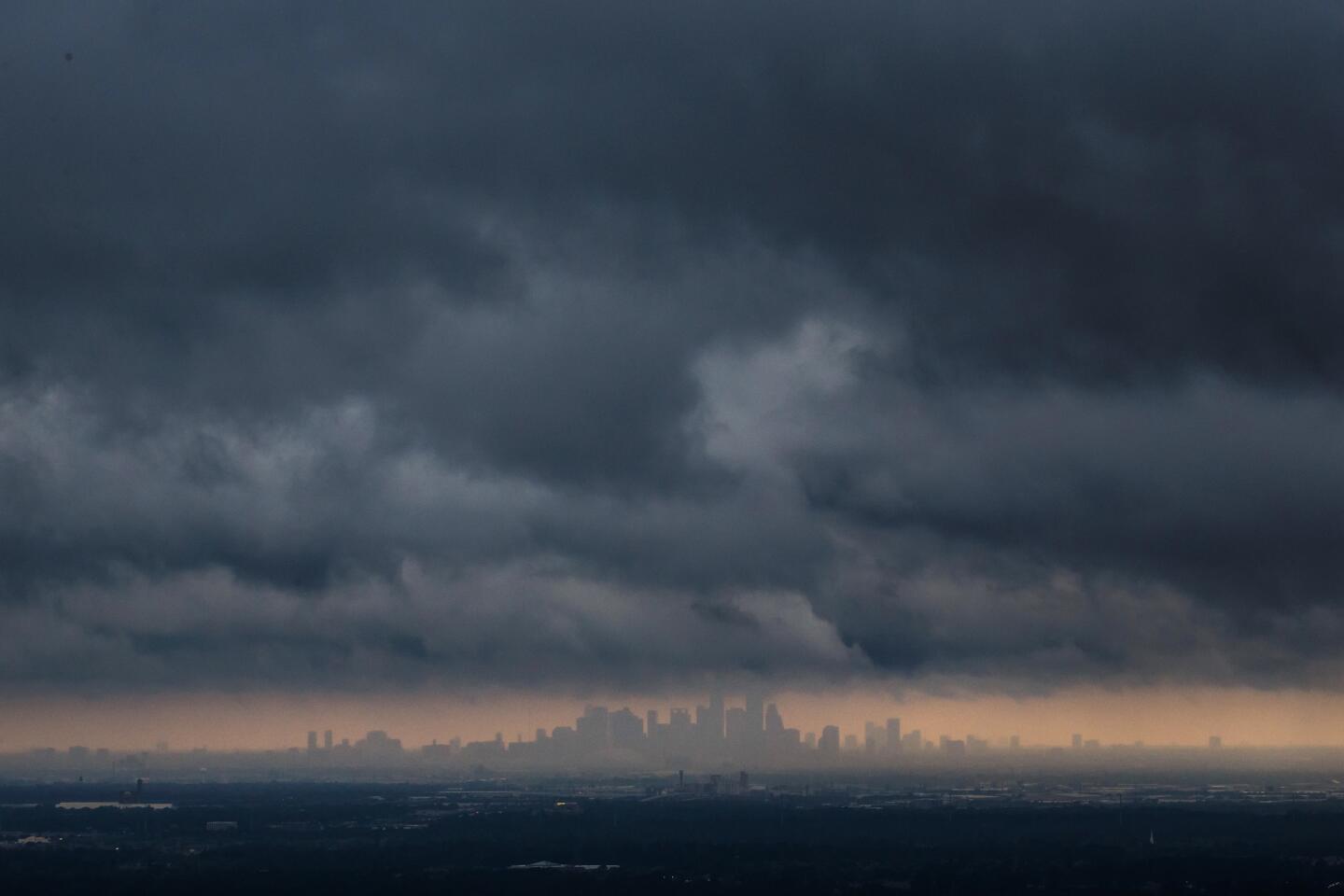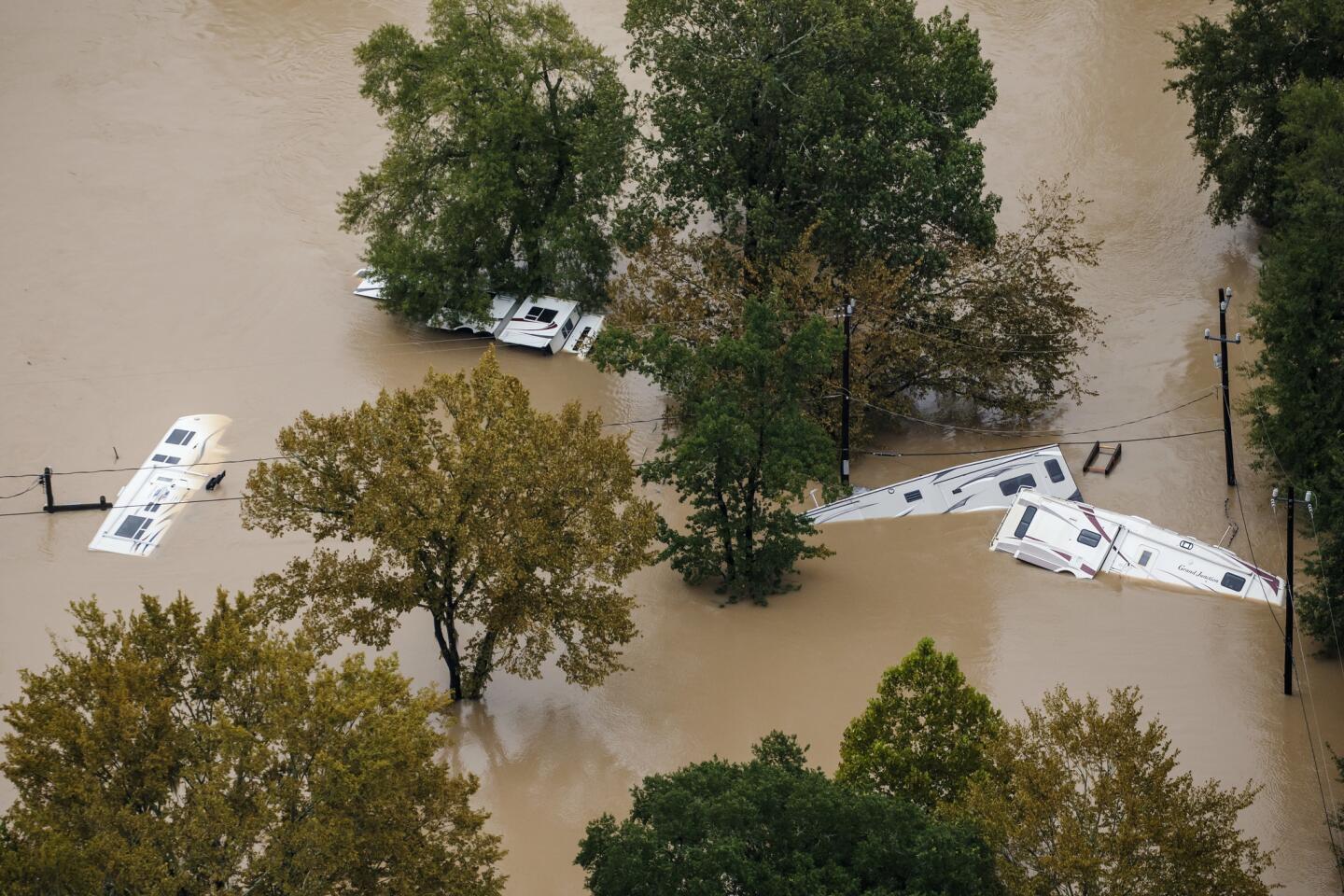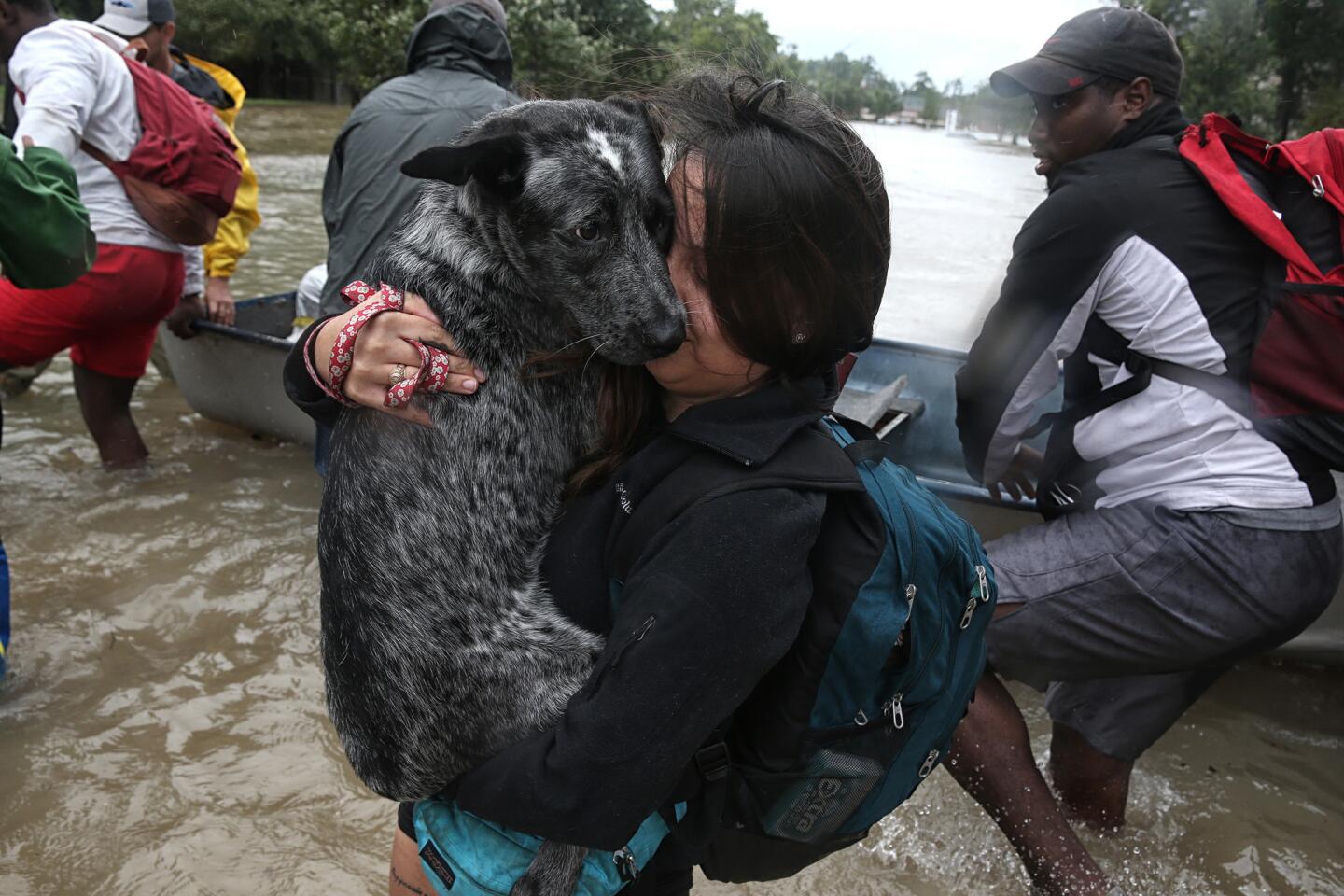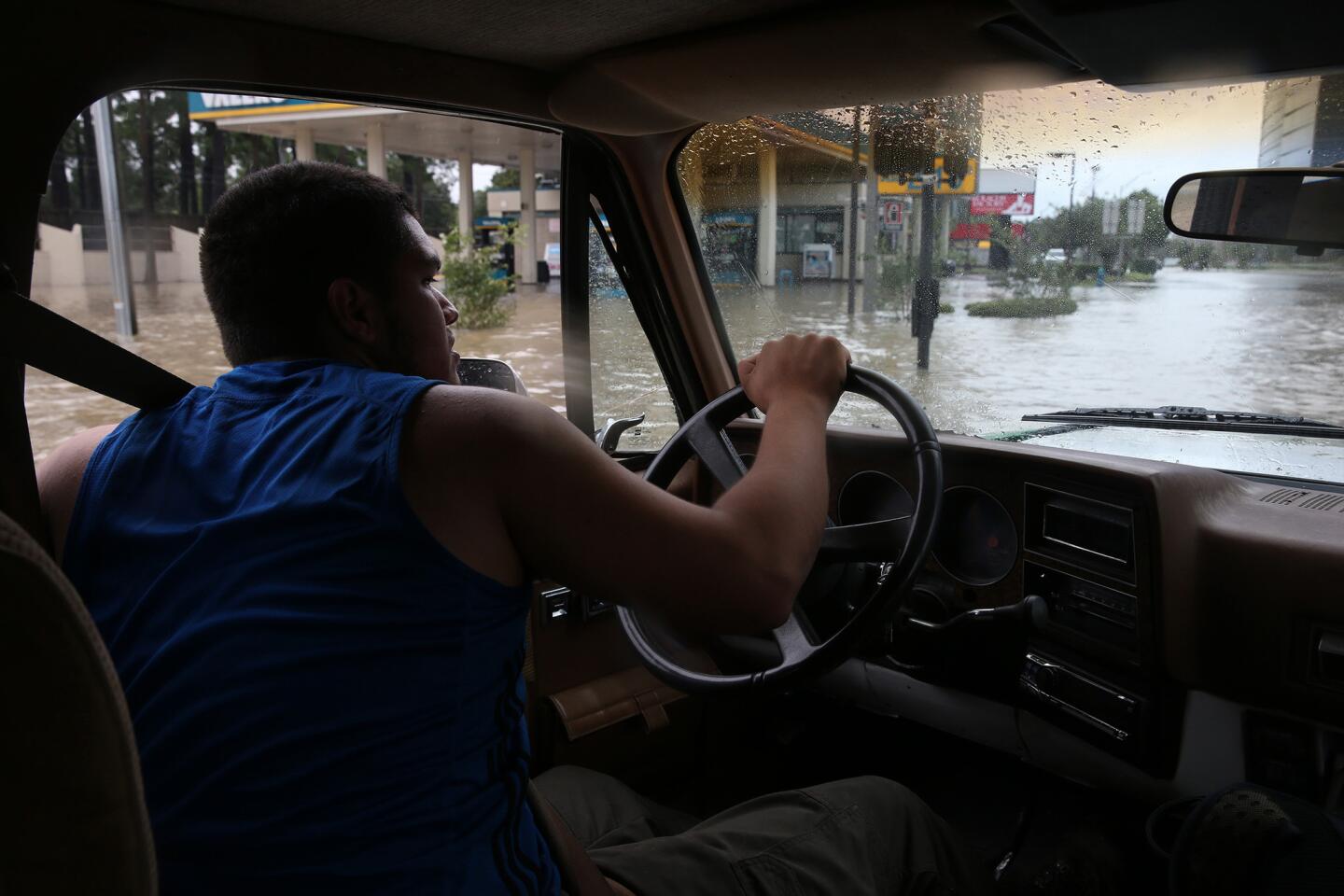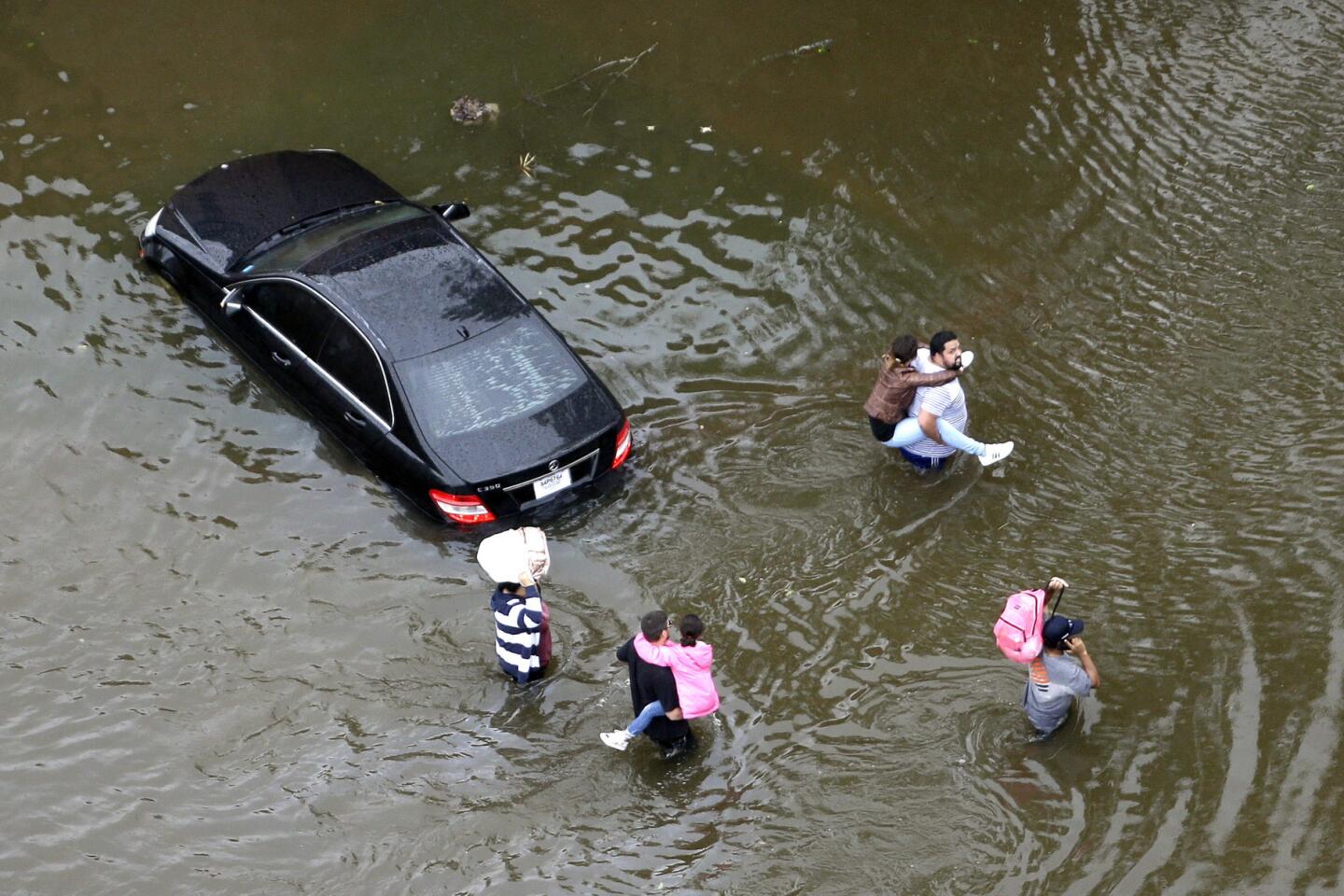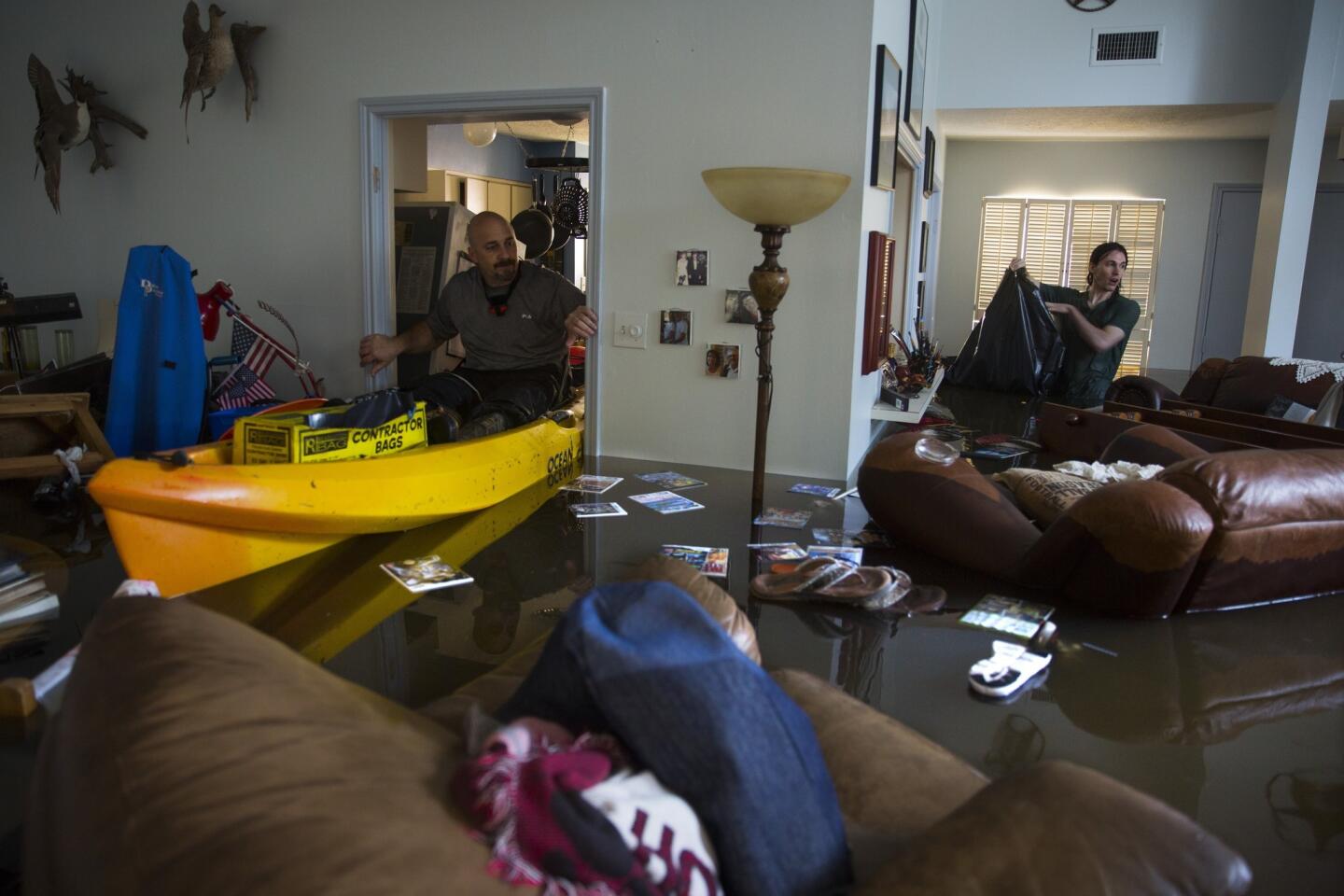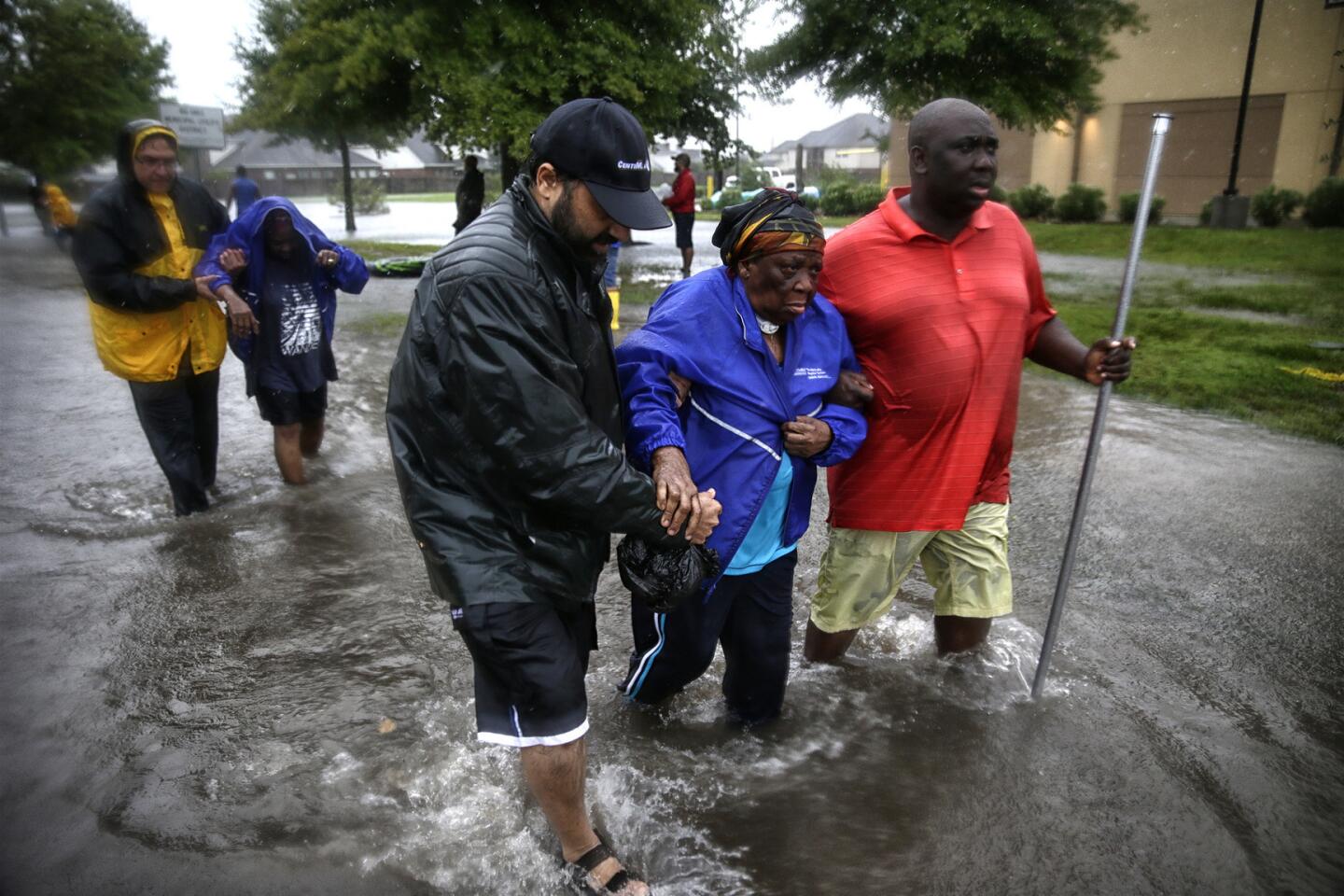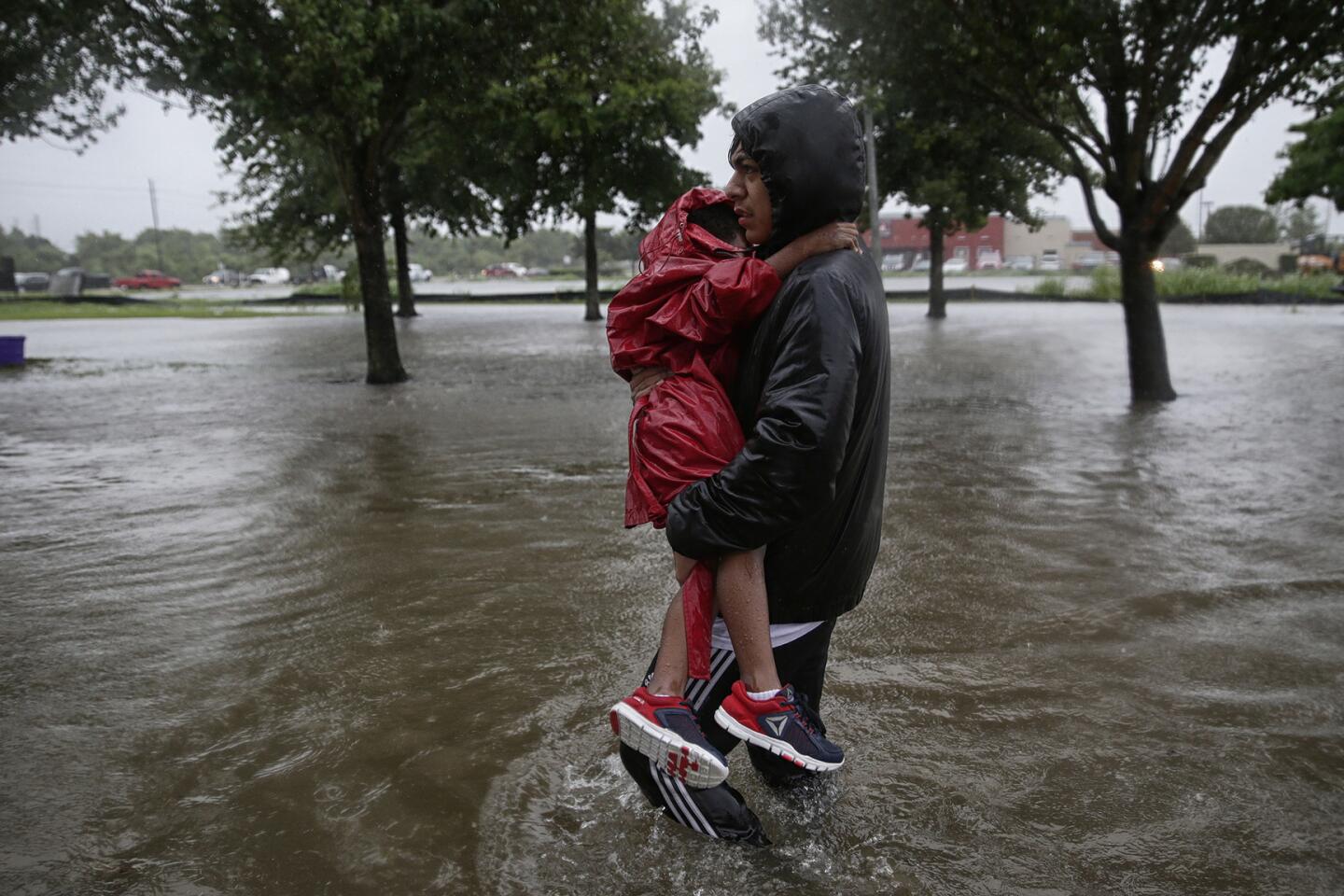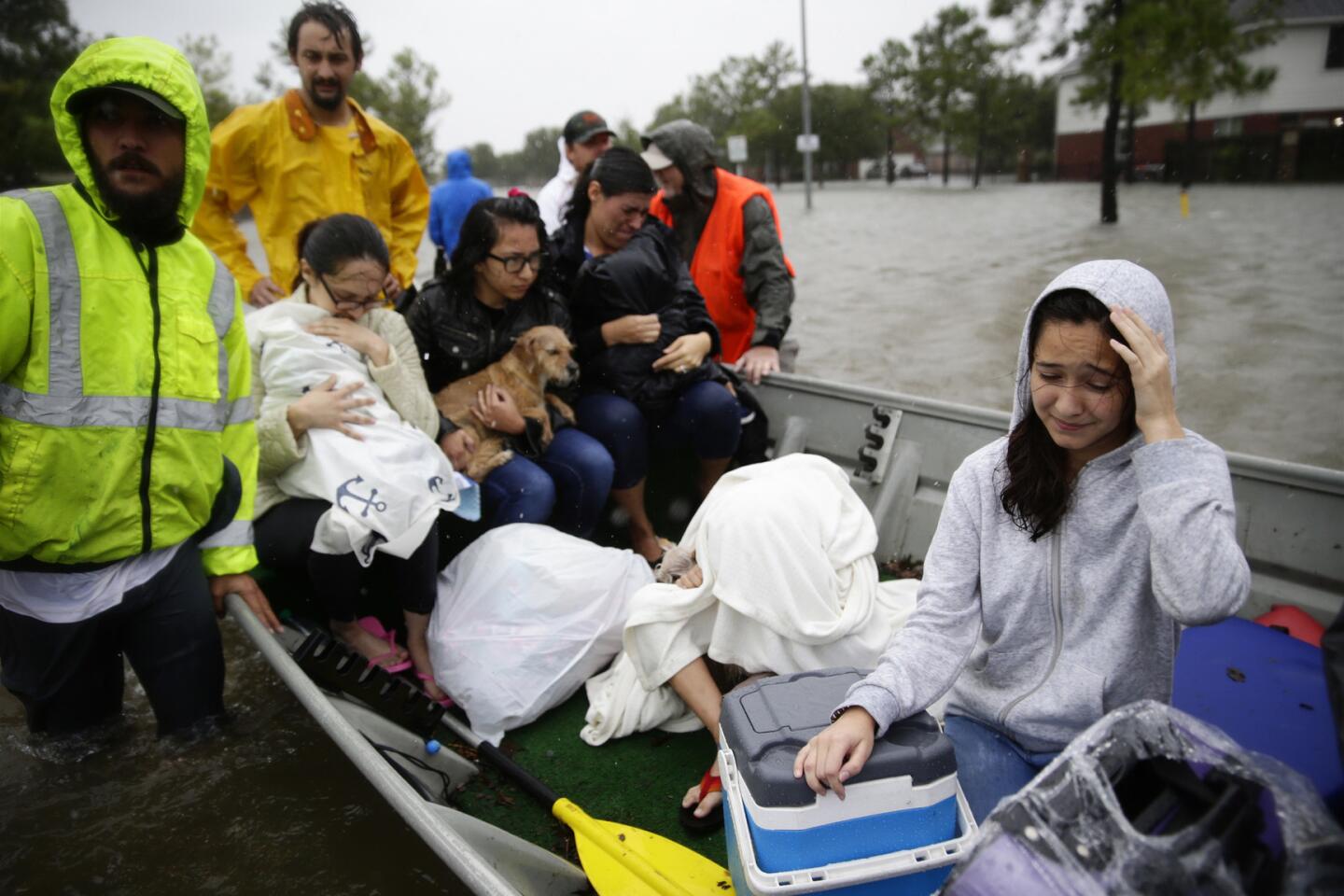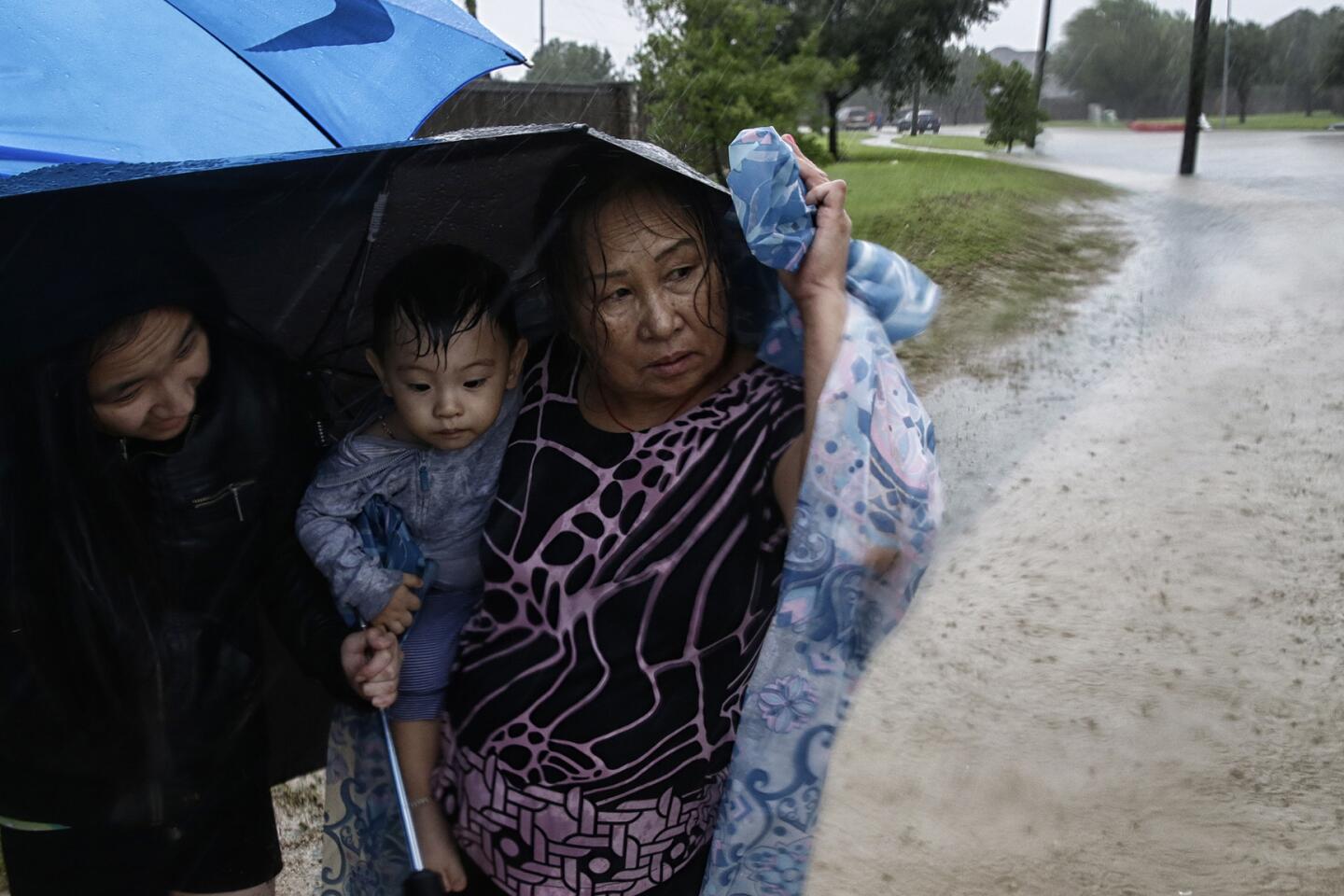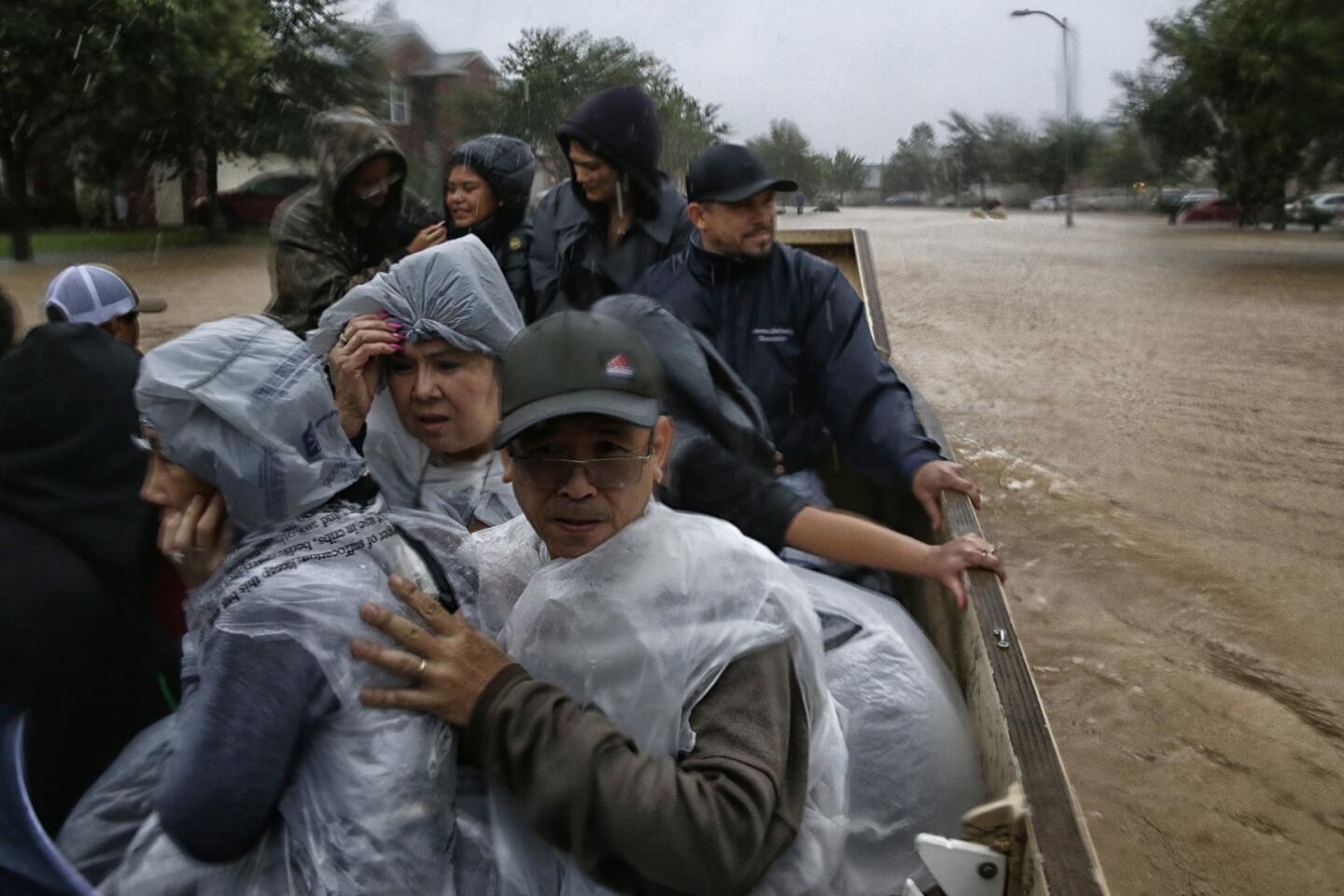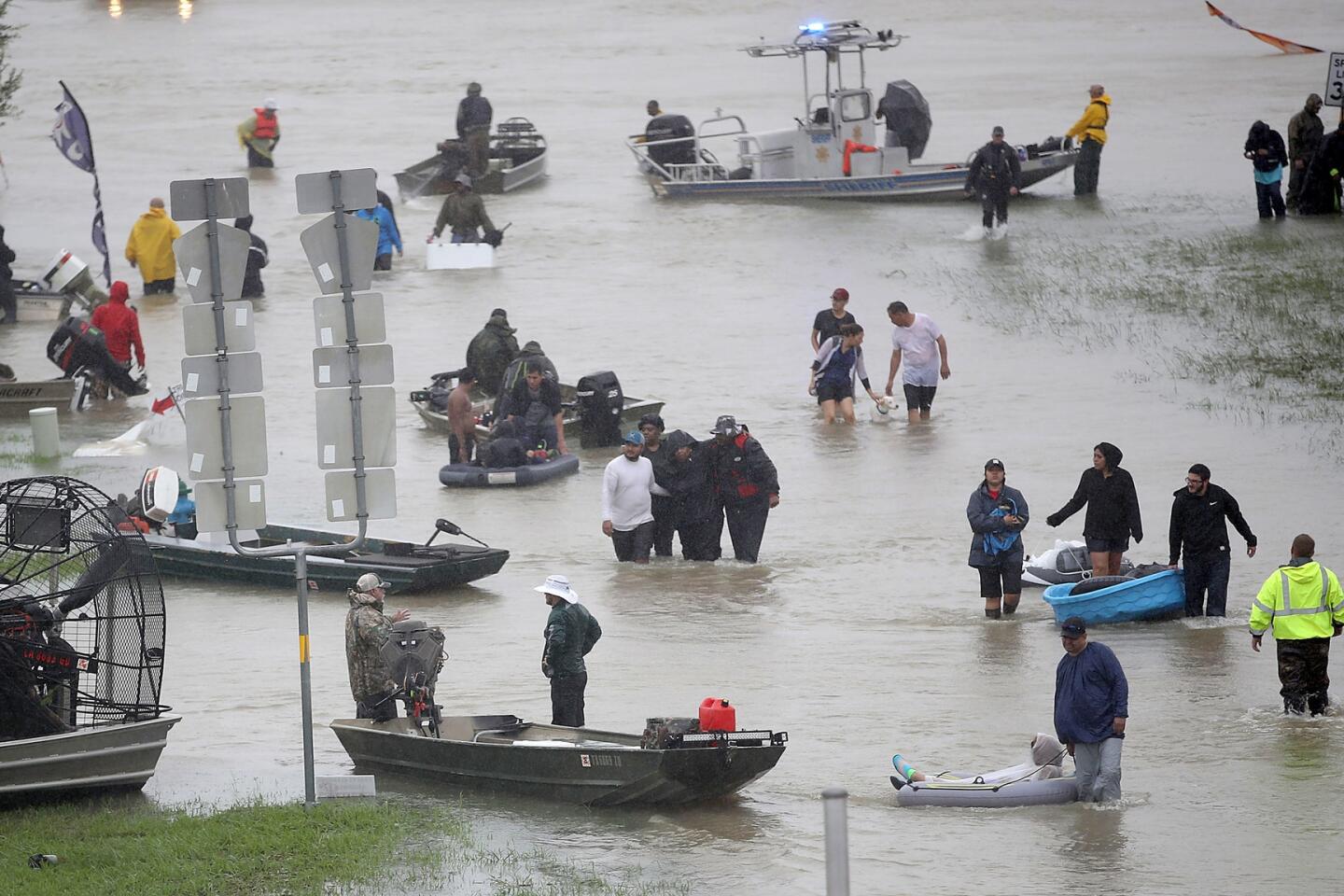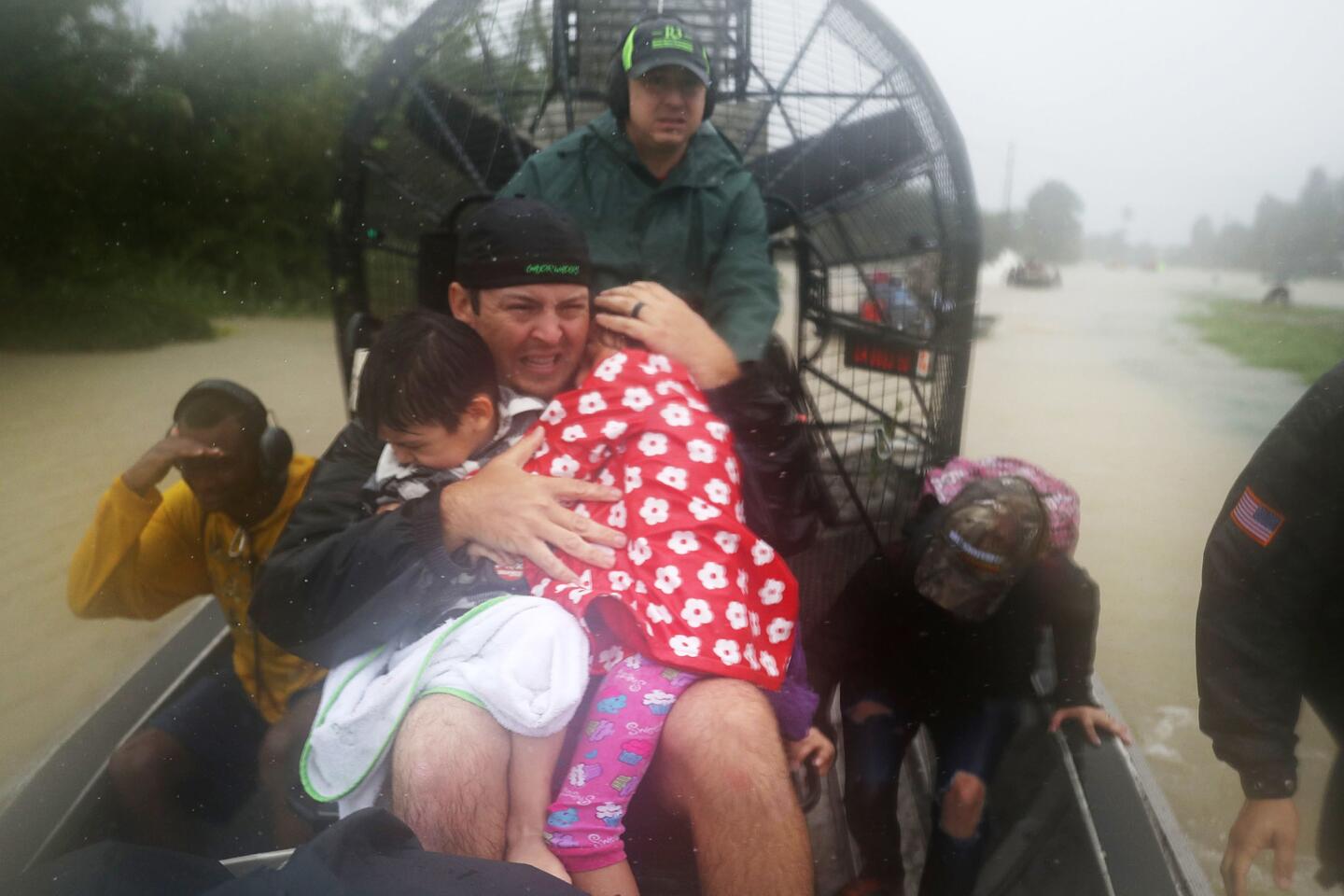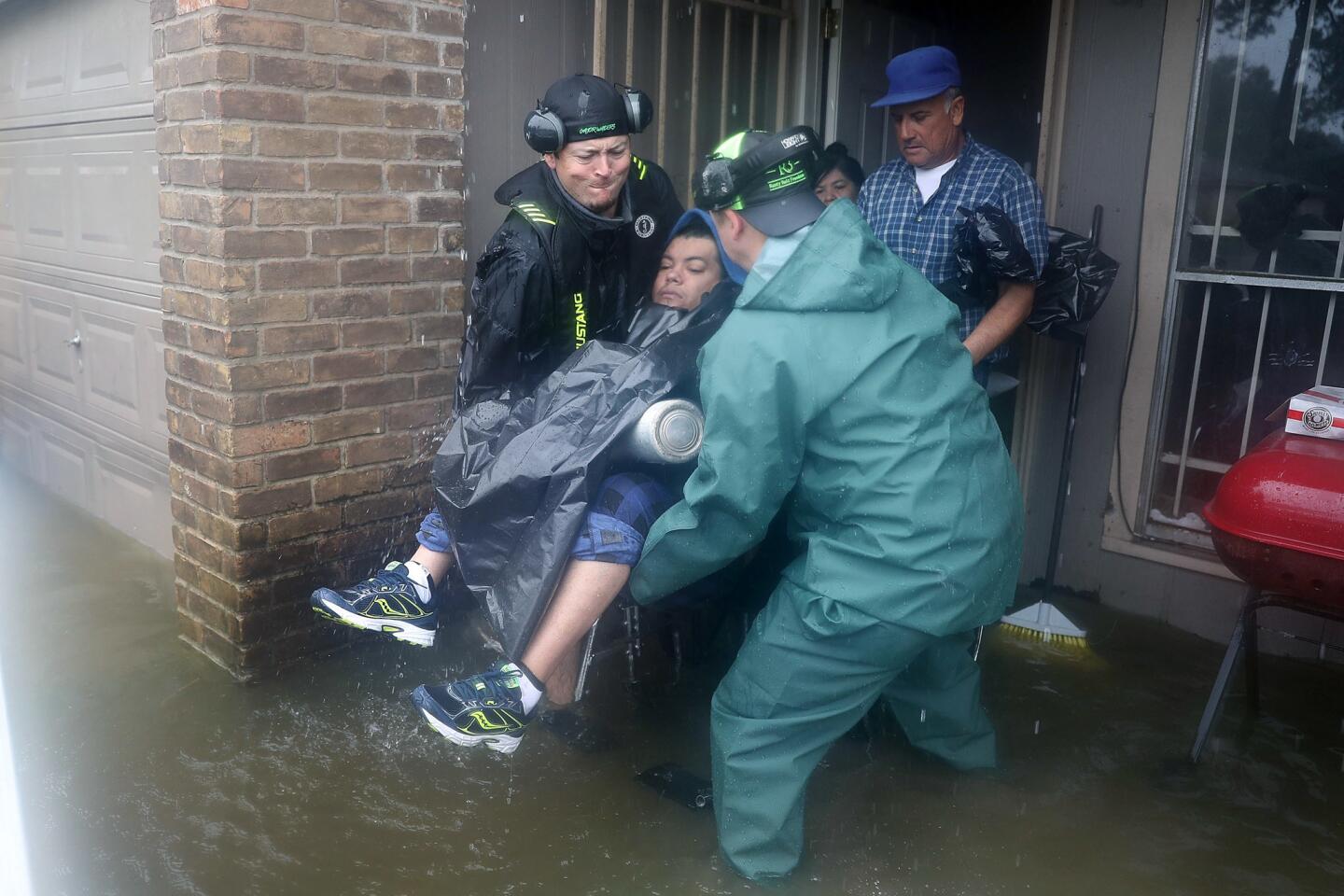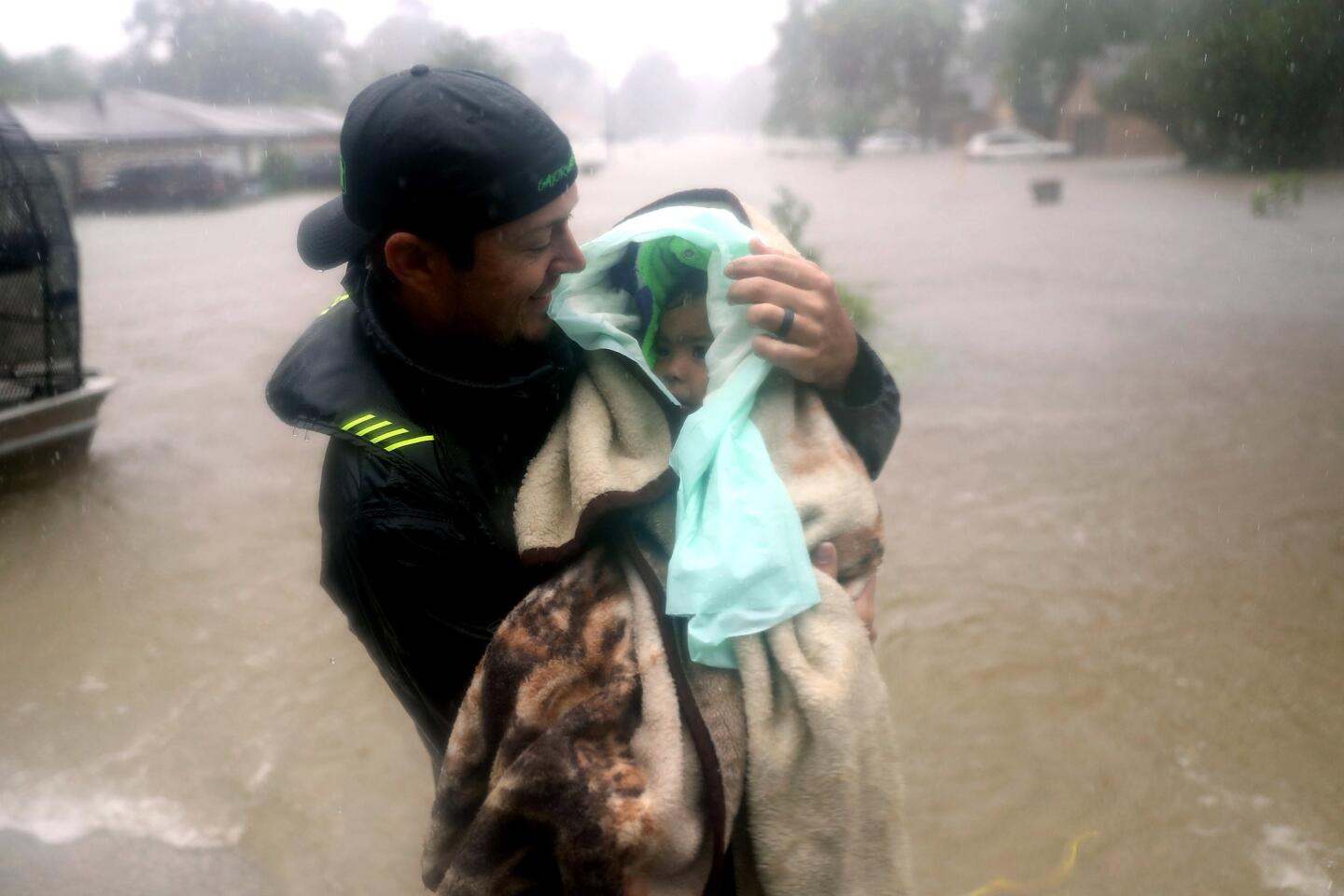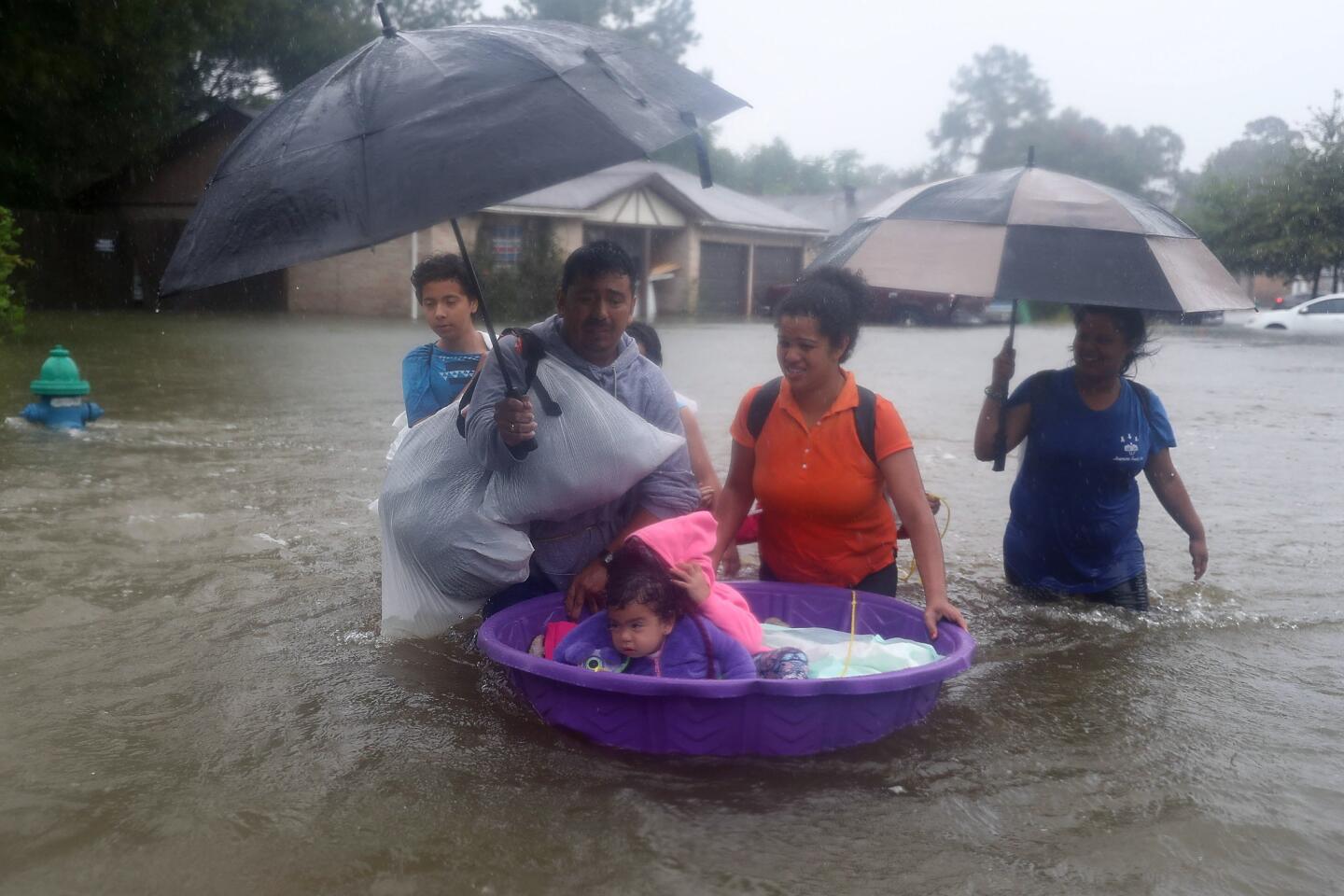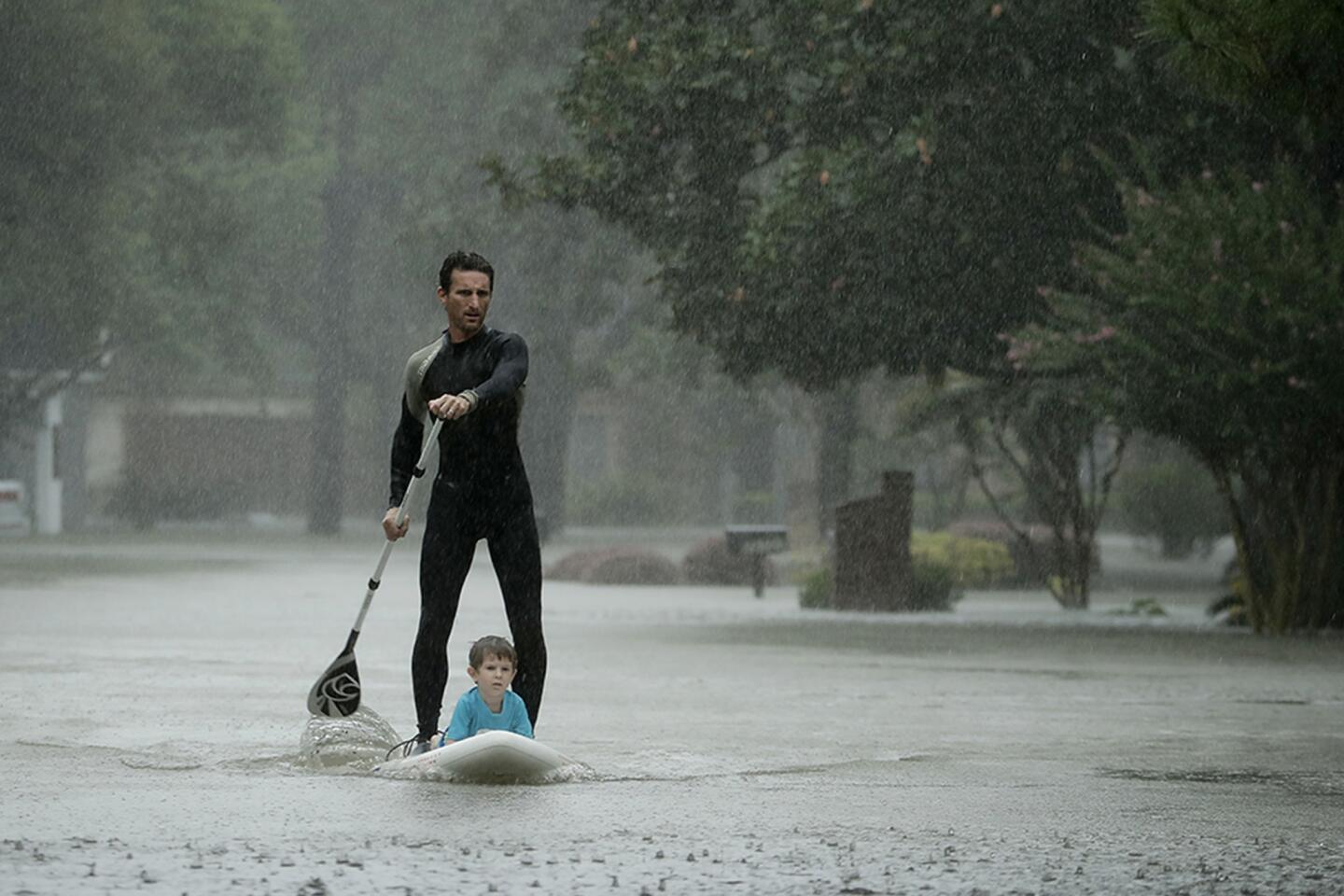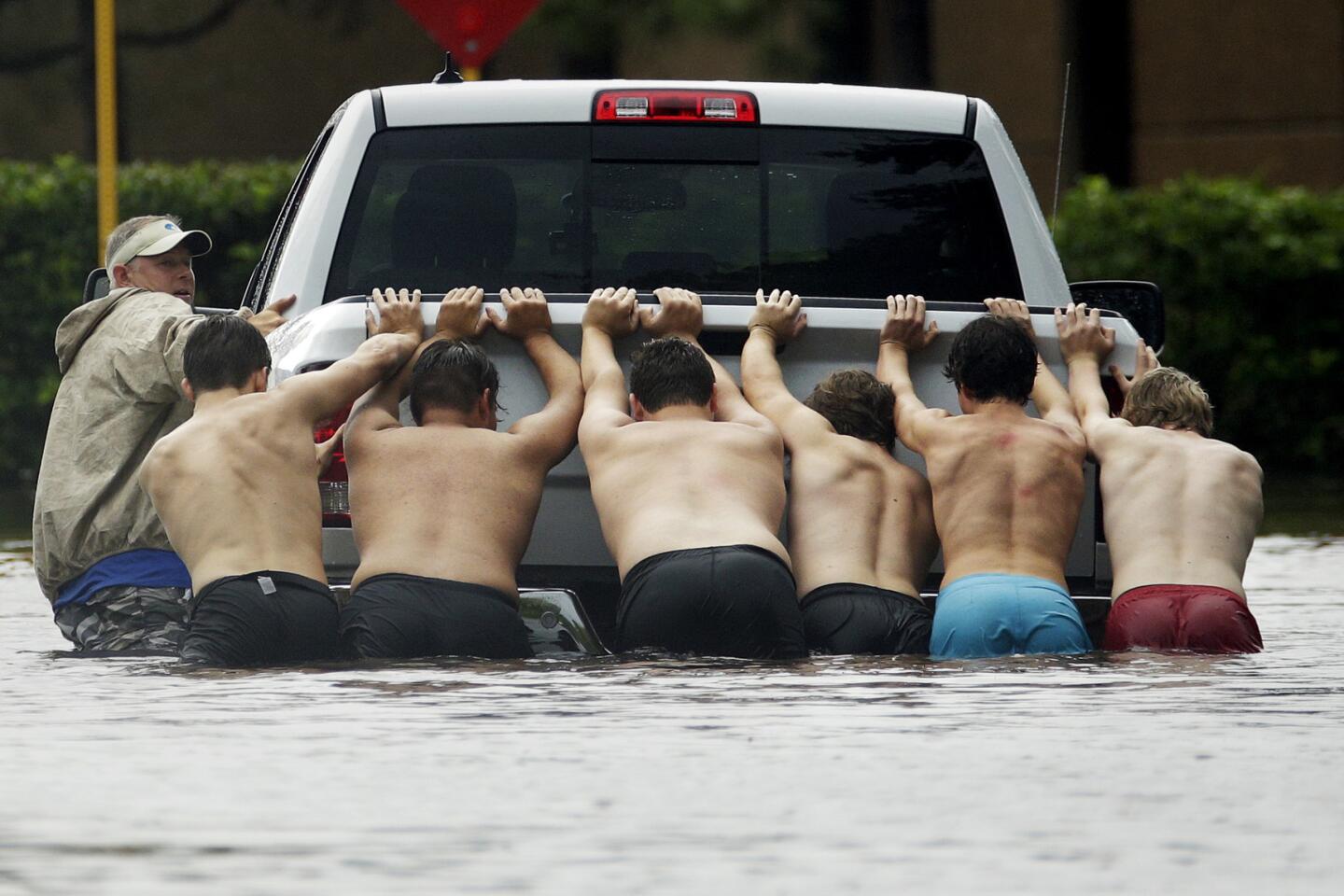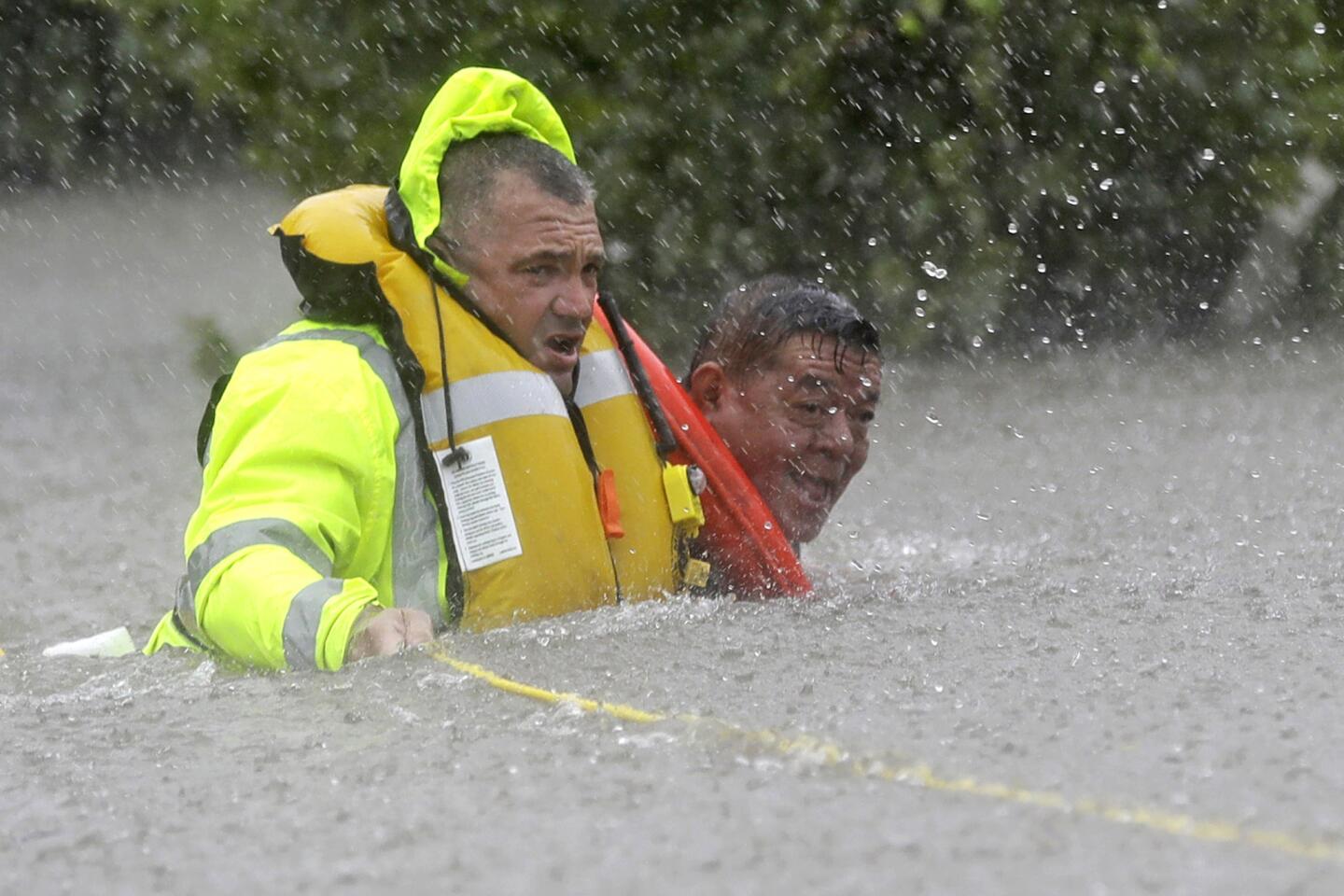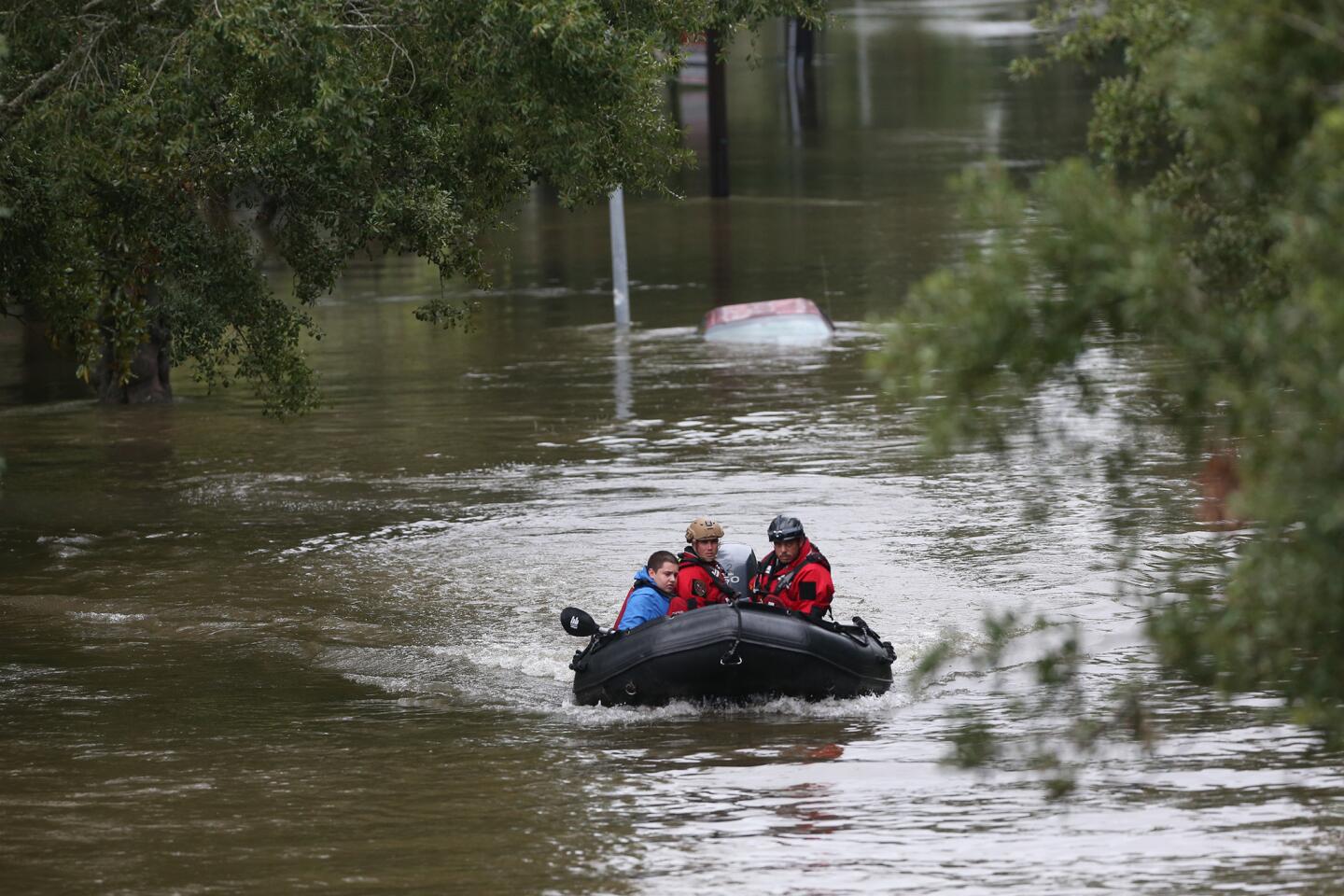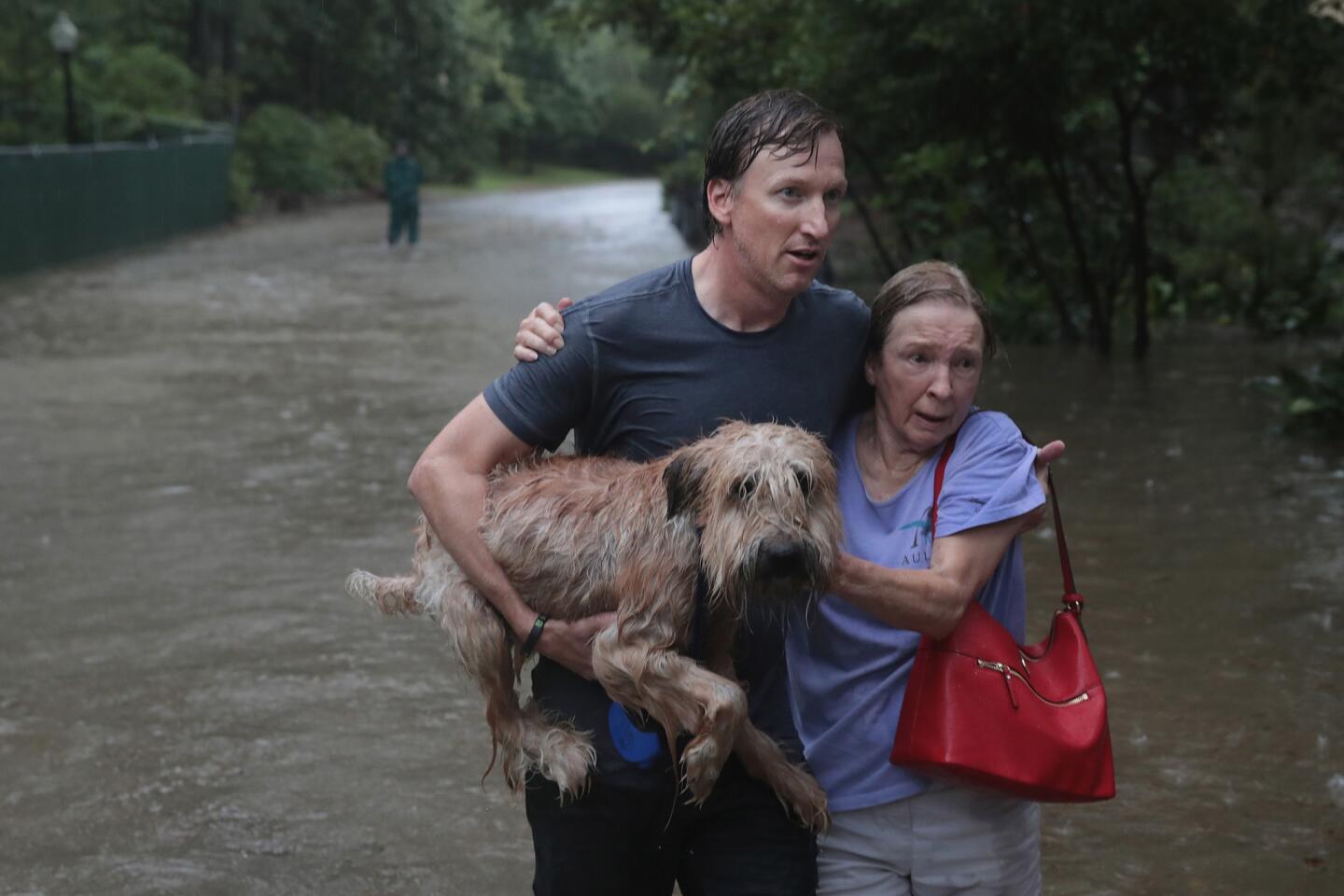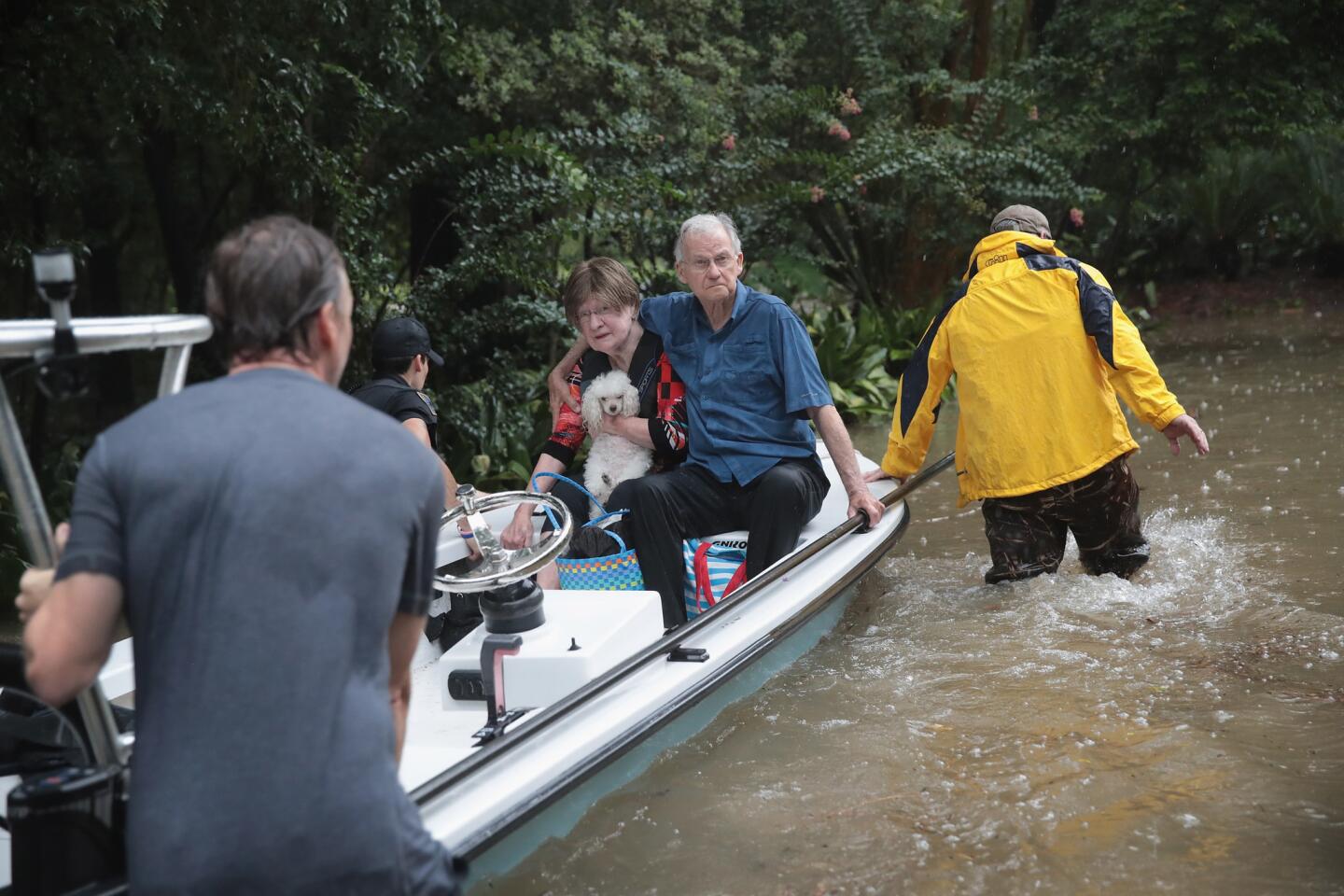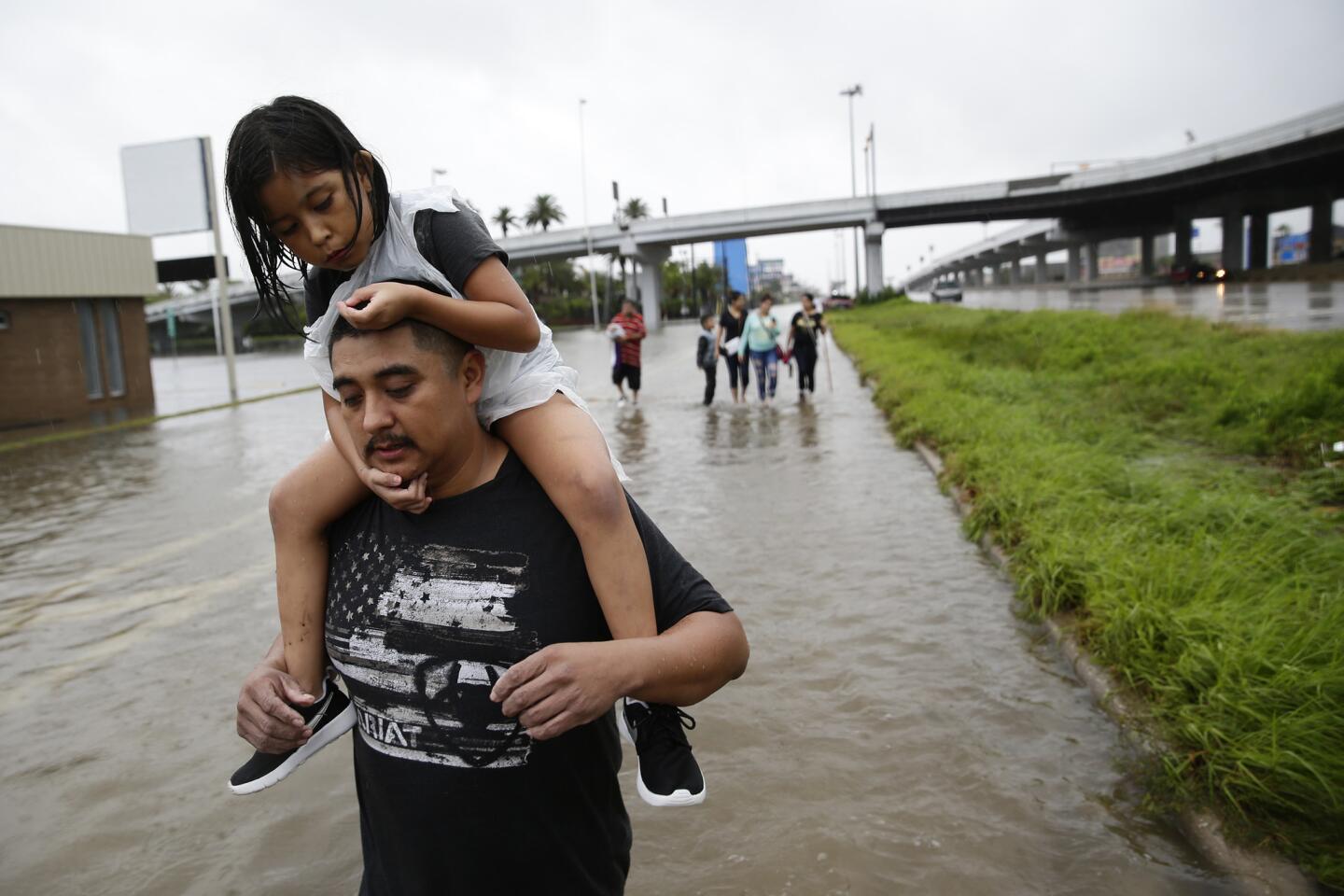Damage toll from Hurricane Harvey mounts as rescue workers strive to reach stranded communities
- Share via
Reporting from Victoria, Texas — Search and rescue teams sifted through wreckage across Texas Saturday after Hurricane Harvey slammed into the Gulf Coast as a powerful Category 4 storm, flattening mobile homes, tearing roofs off buildings and leaving more than 300,000 homes and businesses without power.
Across southern Texas, officials had yet to uncover the full extent of the damage. Heavy rain and lashing winds had covered roads in debris, blocking access to many small towns and rural areas.
Roy Laird, assistant chief with the Rockport Volunteer Fire Department, said three people were dead in Aransas County. Throughout the day, emergency responders combed through the debris of collapsed buildings, broken power poles and uprooted palm trees.
With winds topping 130 mph, Harvey is the first Category 4 storm to make landfall in the United States since Hurricane Charley struck Florida in 2004, and the first to hit Texas since Hurricane Carla in 1961.
Even as Harvey weakened Saturday to a tropical storm with 65 mph winds, weather officials warned residents to expect “extremely serious” flooding, life-threatening storm surges and tornadoes.
“Tropical storm barely moving,” the National Hurricane Center in Miami said in an afternoon advisory Saturday, noting that the storm was stalling about 45 miles northwest of Victoria and was not expected to leave the area for days. “Torrential rains will continue.”
“This is just the beginning,” said Jeff Evans, a meteorologist in the National Weather Service’s Houston/Galveston office. “We could see catastrophic flooding for a lot of people, historic flooding for parts of Texas. We’re looking at measuring rainfall not in inches, but in feet.”
The eye of the storm made landfall about 10 p.m. Friday near Rockport, a small fishing town about 30 miles northeast of Corpus Christi, snapping trees, tossing boats onto roads and demolishing homes and businesses.
“It’s about what you would expect if a Category 4 hurricane entered your front door,” said Rockport Mayor Charles “C.J.” Wax, who had evacuated to San Antonio. “Widespread devastation.”
At the Saltgrass Landing apartment complex, several brick buildings were destroyed. It looked as if the seaward half of each building had simply melted under the force of the hurricane’s winds, exposing the interiors for anyone to see.
One crib on a second-floor apartment was piled full of blankets and soggy bits of dry wall and insulation. Dressers and washing machines had toppled out of the building. But there were no sounds of shouting, or crying, or saws and hammers. Just an atonal symphony of smoke alarms from several apartments and the barking of two lost dogs.
Mobile home parks in the city were similarly devastated and abandoned, with many homes tossed on their sides. One home near the Four Seasons Mart was destroyed. No trace of its owner was left except for the overpowering odor of spilled cologne.
Republican Gov. Greg Abbott expanded a state of emergency from 30 to 50 counties Saturday. At a news conference he said that there had already been about 20 inches of rain in Corpus Christi and about 16 inches in Houston.
“Our primary concern remains dramatic flooding,” he said. “Our biggest concern is the possibility of between 20 and 30 more inches of rain.”
Rockport’s firefighters worked Saturday with no Internet service and only one phone line, which rang nonstop as residents called to ask responders to check in on their loved ones. Many people haven’t been able to reach family and friends since the storm hit and knocked out cellphone service.
The city has been threatened many times by storms that didn’t turn out to be devastating. Many people, Laird said, chose to wait out Harvey instead of evacuating.
“This is something that just snuck up on us,” he said. “We did the best we could with the time we had.”
Amid drizzle and pummeling winds, the city’s two emergency teams were using backhoes, dump trucks and bulldozers to clear debris off the roads and allow ambulances and firetrucks to traverse the city.
“I’m very worried about the days ahead,” Mayor Wax said, noting that rain falling farther inland was likely to flow to the coast and into his community. “We’ve already been hit once with the storm. Now we’re going to get hit again with a flood.”
Outside Rockport, a marina had been transformed into a graveyard of pleasure boats. Blown open by the winds, a mass storage structure revealed boats smashed into each other like a pile of dominoes. The remaining sheet metal on the structure clattered and groaned in the winds as a handful of boat owners tried to secure the area.
Kelly White, 45, and Terry Reed, 63, both of Rockport, had fled the storm before landfall, then accidentally drove into a tornado when they first tried to return early Saturday morning.
The cyclone briefly lifted the back wheels of Reed’s Chevy Tahoe off the ground, leaving the tires accelerating helplessly when he hit the gas. That’s when they decided to turn back.
Now they were trying to board up a friend’s marina-front home after the storm blew in the windows on one end and propelled the contents of the home out the other.
“He let us drink beer on his porch, so we keep his house in shape,” said White as the men nailed a soggy piece of particle board over an exposed window.
Reed was relieved to discover that his boat, which had been tied to the dock, had only been tossed to the opposite side of the marina instead of sinking to the bottom.
“This wasn’t a major, major hurricane,” Reed said.
Richard Helmich, 72, was not so lucky. His boat, the Gypsy Soul, was pinned between two larger boats. He also lost his 54-foot house trailer. Now he stood among his scattered belongings where a storage hut at the marina had tipped over and spilled its contents.
“Hard to believe this was the roof,” Helmich said, looking at the pile of wood in front of him.
About 20 miles south, the small town of Port Aransas on Mustang Island suffered heavy damage.
“Our town took a real beating,” Mayor Charles R. Bujan said. “We took a major hit, but there was no life lost — no injuries — thank God.”
The hurricane wreaked havoc in the town’s marina, he said, and the Pioneer RV Beach Resort, a trailer park nestled in the sand dunes south of downtown, was destroyed.
“It is 100% gone,” he said. “Luckily, the owner made everyone there leave.”
In Victoria, a town of 62,000 people about 30 miles from the coast, heavy rains were pounding sideways Saturday as ferocious winds lashed the city.
The streets were empty of cars and littered with downed trees and power lines. Several gas station overhangs had collapsed and fallen onto the pumps below. Water began to pool on neighborhood streets.
At a Red Cross shelter, more than 300 residents huddled inside, slumped on cots as they awaited news about the storm.
The initial hurricane warning spanned a wide stretch of coastline from Port Mansfield to Sargent, an area that is home to about 4 million people. An additional 12 million, many in the major cities of Houston and San Antonio, were under a tropical storm warning.
What makes Harvey so potentially dangerous, even as it weakens, is that it will continue to linger in the area, meteorologists say.
“Typically, a hurricane comes in and pulls inland,” Laird said, “but this is moving slowly, and it’s expected to stall, wobble and maybe loop back to where it came in.”
On Saturday morning, the National Weather Service warned that some areas could get as much as 40 inches of rain — about the amount of rainfall many Texas coastal towns get in a year.
Along the coast, some residents ventured out Saturday morning to check on family and friends. “It’s like a little ghost town,” Eddie Canales, 69, said as he drove his car across Corpus Christi — past broken fences, toppled trees and dark traffic lights — to check on his uncle and cousins.
“There’s very little traffic,” Canales said. “All the Whataburgers are closed — every single one of them.”
The winds had calmed, and there was little floodwater, he said. With his house intact, his main concern was when power would be restored.
“Everything seems to be getting back to normal,” Canales said. “If electrical power comes back, I’ll be prepared. If not, I’ll have to move further inland.”
Before the eye of the storm reached land, President Trump announced on Twitter that he had granted Gov. Abbott’s request for a disaster declaration, “which unleashes the full force of government help!”
Shortly after midnight, downgraded to a Category 3 storm, Harvey made a second landfall along the northeastern shore of Copano Bay, the National Weather Service reported.
Before Harvey, the most recent major hurricane to make landfall was Wilma, a Category 3 storm that hit Florida in October 2005, two months after Hurricane Katrina.
Historically, slow-moving tropical storms and hurricanes have caused some of Texas’ most severe flooding. In 2001, Tropical Storm Allison hovered above the Houston area for days, in some neighborhoods dumping up to 30 inches of rain — as much as 80% of the area’s average annual rainfall.
The last hurricane to hit the Texas coast — Hurricane Ike, a Category 2 storm that wreaked havoc after making landfall in Galveston in 2008 — killed at least 37 people and resulted in more than $30 billion in damage.
Hurricane Harvey poses the first major test of emergency response for the Trump administration and the Federal Emergency Management Agency’s new administrator, Brock Long, who was confirmed in June.
Trump plans to travel to Texas next week, Homeland Security advisor Tom Bossert said. Speaking to reporters at a news briefing Friday, he added that federal officials had significantly improved their ability to respond to natural disasters since Hurricane Katrina caused widespread flooding in New Orleans in 2005, and that the president seemed determined to provide help to Texas in the face of the storm.
In some parts of Texas, residents were bombarded with contradictory advice from state and local officials as the storm approached.
On Friday afternoon, Abbott urged residents of low-lying and coastal areas prone to flooding — including parts of Houston — to evacuate.
“What you don’t know and what nobody else knows right now is the magnitude of flooding that will be coming,” the governor said.
Shortly afterward, Houston Mayor Sylvester Turner reminded residents that city officials had not issued an evacuation order and urged them to stay in place, noting that residents fleeing Hurricane Rita in 2005 had caused major traffic chaos.
“Please think twice before trying to leave Houston en masse,” he said on Twitter. “No evacuation orders have been issued for the city.”
Flash floods and isolated tornadoes popped up throughout the Houston metropolitan area Saturday, closing roads or making them impassable. One tornado hit about 30 miles northwest of downtown just after 4 p.m. and later blew over trees and caused minor roof damage to a home, said Paul Lewis, a meteorologist in the National Weather Service’s Houston/Galveston office.
In the coming days, the storm’s impact is likely to be felt in neighboring Louisiana, where Democratic Gov. John Bel Edwards declared a state of emergency Thursday for the entire state.
Just a few inches of rain could cause severe challenges in New Orleans, which is still recovering from flooding after thunderstorms earlier this month overwhelmed the city’s drainage system.
New Orleans police officers set up barricades in flood-prone areas Saturday to prevent drivers from venturing into high water. Emergency officials did not advise residents to evacuate but urged them to keep sandbags on hand, stock up with three days’ worth of supplies and remove leaves and other debris from in front of catch basin openings.
Times staff writers Pearce and Castillo reported from Victoria, Texas, and Los Angeles, respectively. Special correspondent Jarvie reported from Atlanta.
Twitter: @mattdpearce
Twitter: @andreamcastillo
MORE NATIONAL NEWS
Farmed Atlantic salmon escape into Washington state waters. Here’s why fishermen are worried
A founder of Black Lives Matter answers a question on many minds: Where did it go?
For one veteran in Reno, a chance to see the president. But he’s seen enough in a divided country
UPDATES:
6:40 p.m.: This article was updated with additional details of the damage in Rockport.
2:50 p.m.: This article has been updated with reporting on New Orleans and the National Hurricane Center.
12:50 p.m.: This article has been updated with details from Rockport and Port Aranas and comments from the Texas governor.
12:05 p.m.: This article was updated with news of three confirmed deaths.
11:15 a.m.: This article was updated with the downgrading of the storm from a Category 1 hurricane to a tropical storm.
10:55 a.m.: This article was updated with conditions in Rockport.
This article was originally published at 8:55 a.m.
More to Read
Sign up for Essential California
The most important California stories and recommendations in your inbox every morning.
You may occasionally receive promotional content from the Los Angeles Times.

